Fiber optic adapter
Lu , et al. December 29, 2
U.S. patent number 10,877,224 [Application Number 16/402,472] was granted by the patent office on 2020-12-29 for fiber optic adapter. This patent grant is currently assigned to COMMSCOPE TECHNOLOGIES LLC. The grantee listed for this patent is CommScope Technologies LLC. Invention is credited to Yu Lu, Randy Reagan.
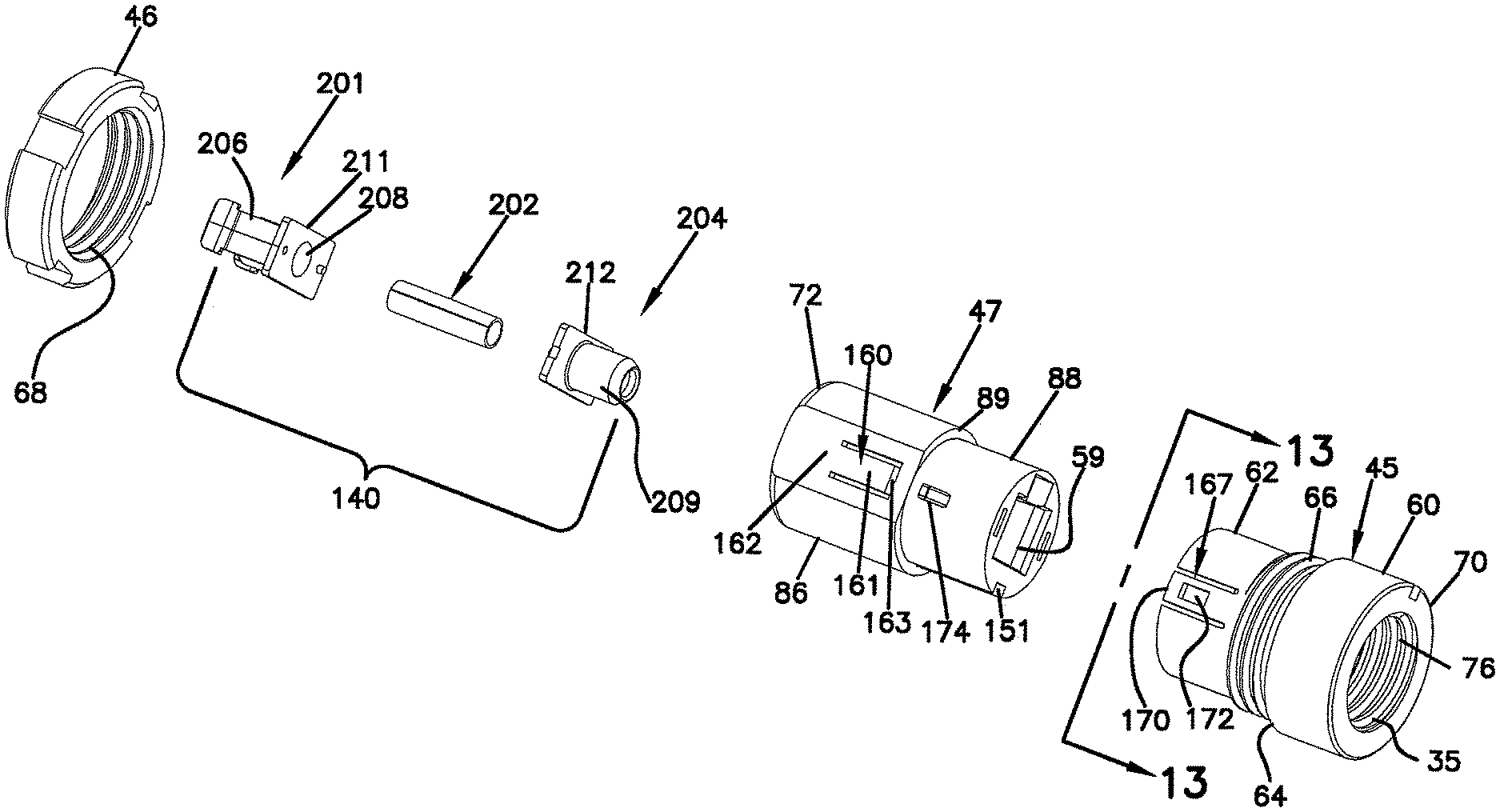
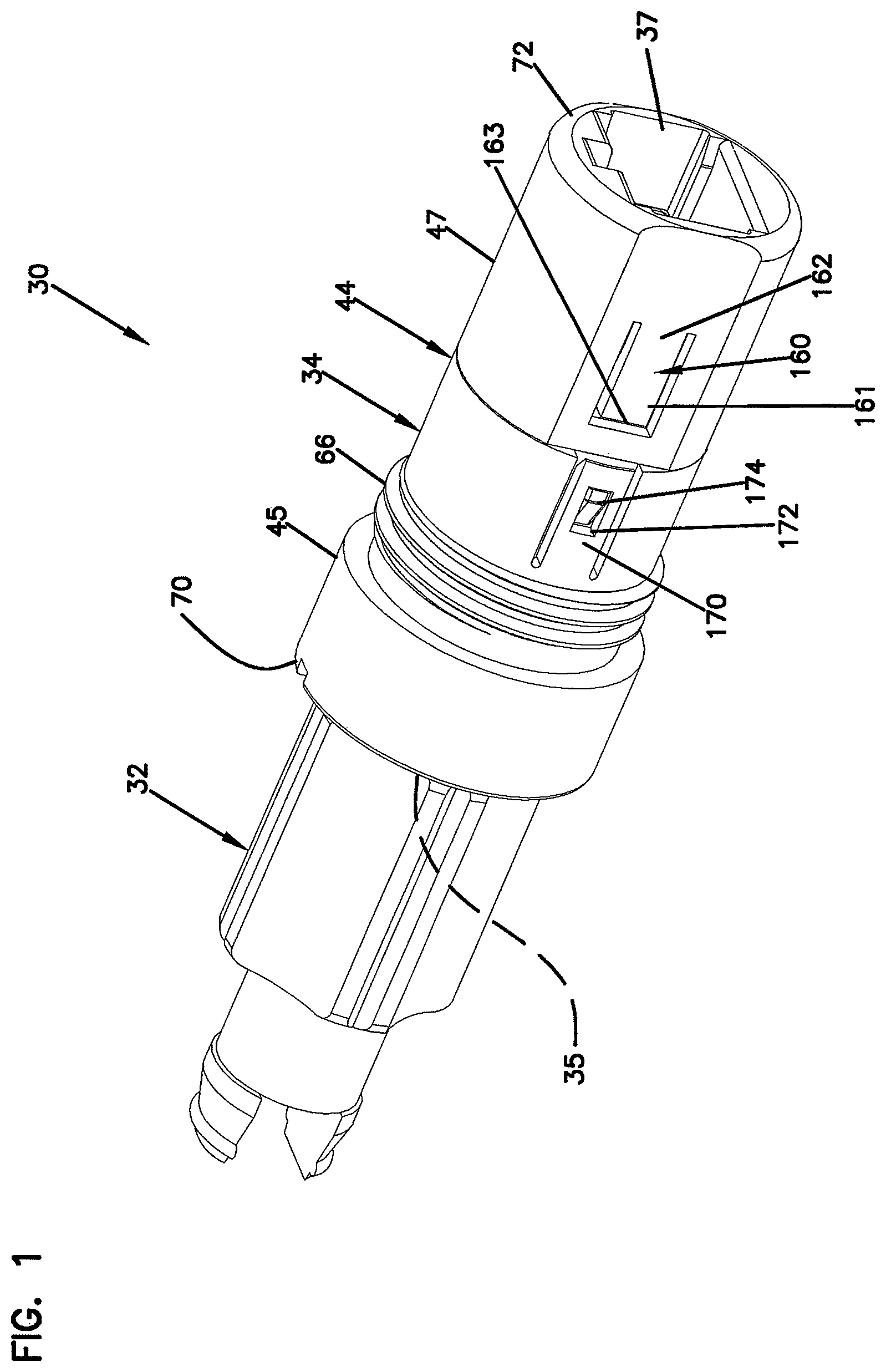
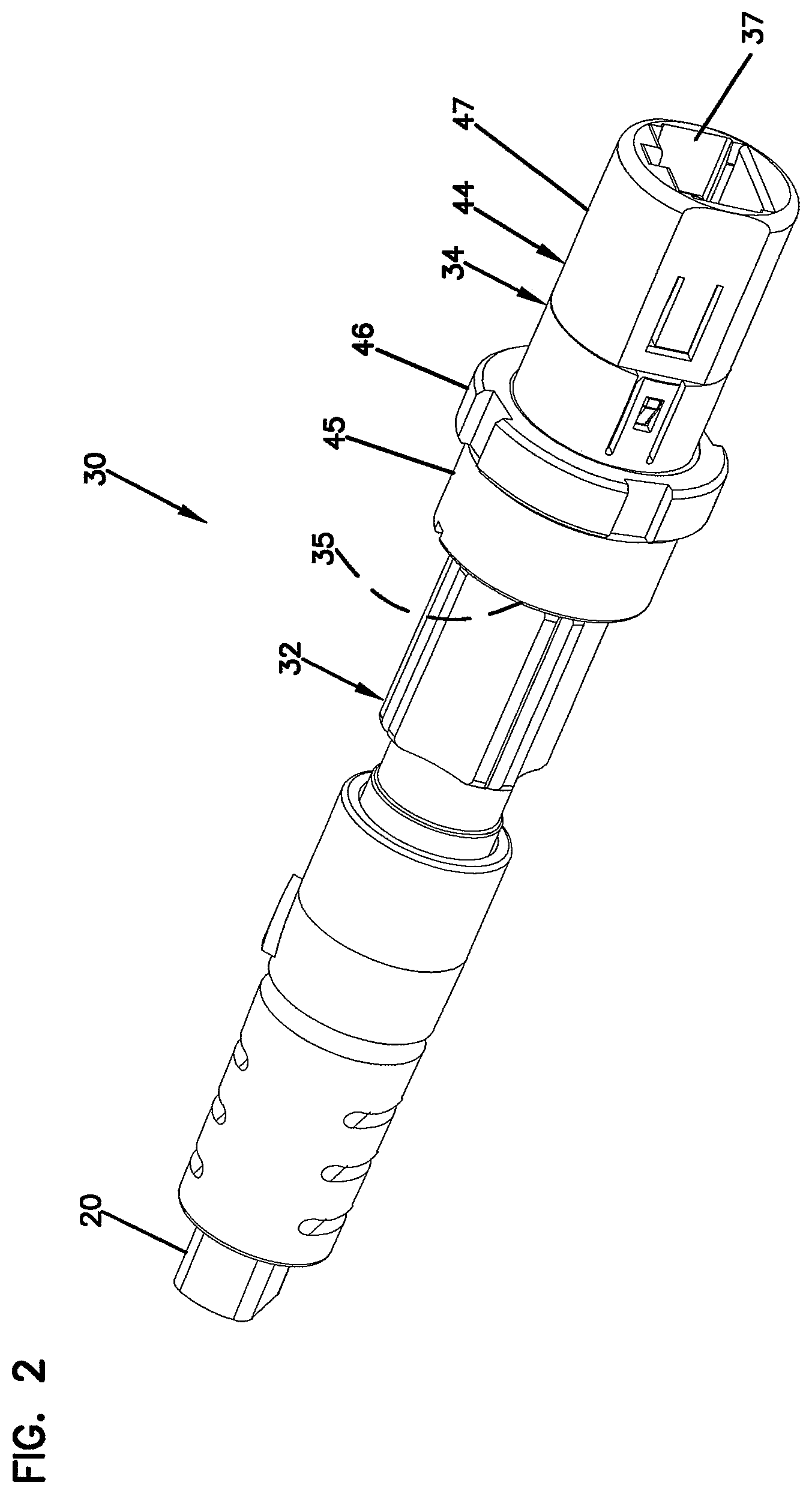
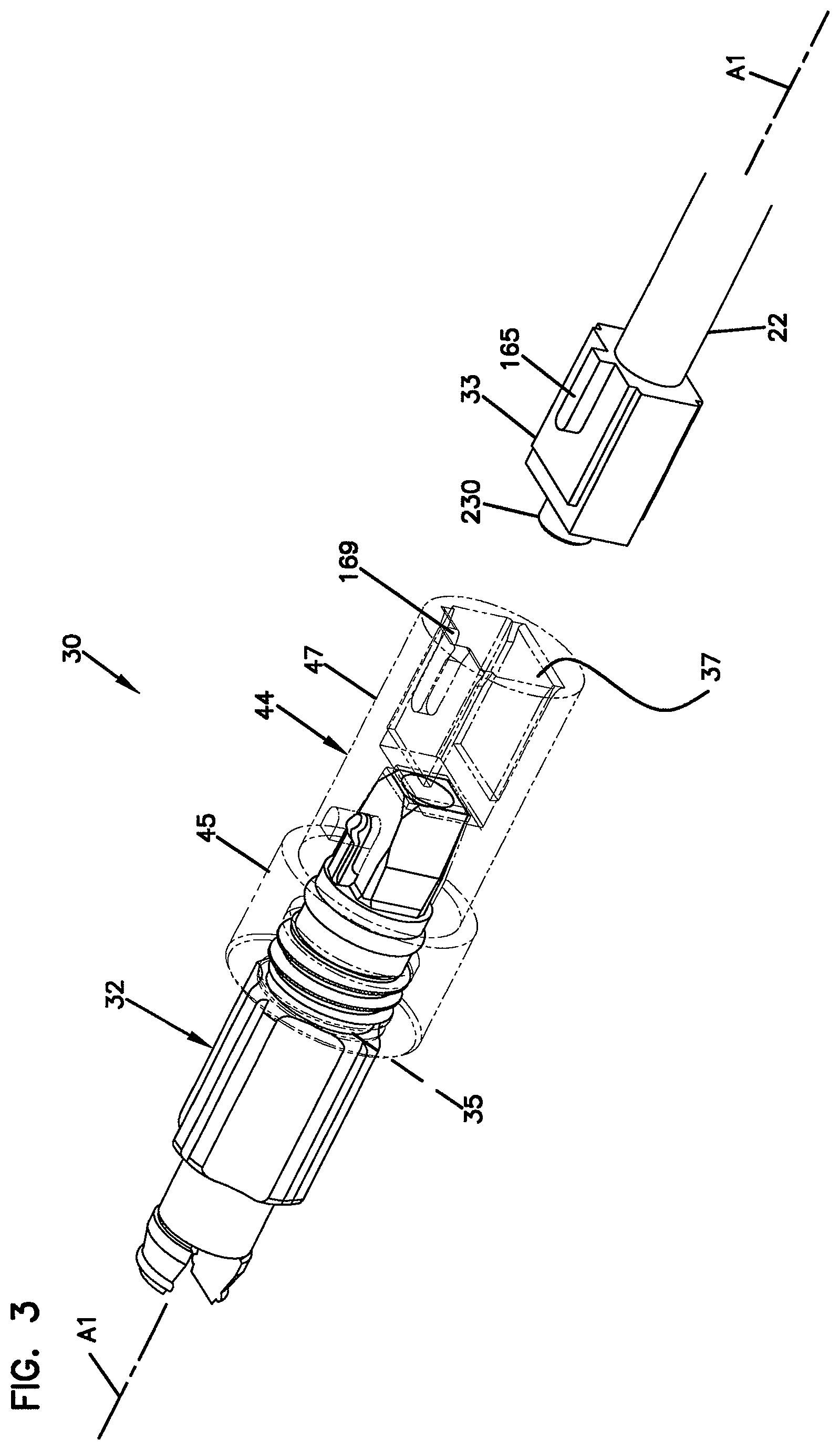
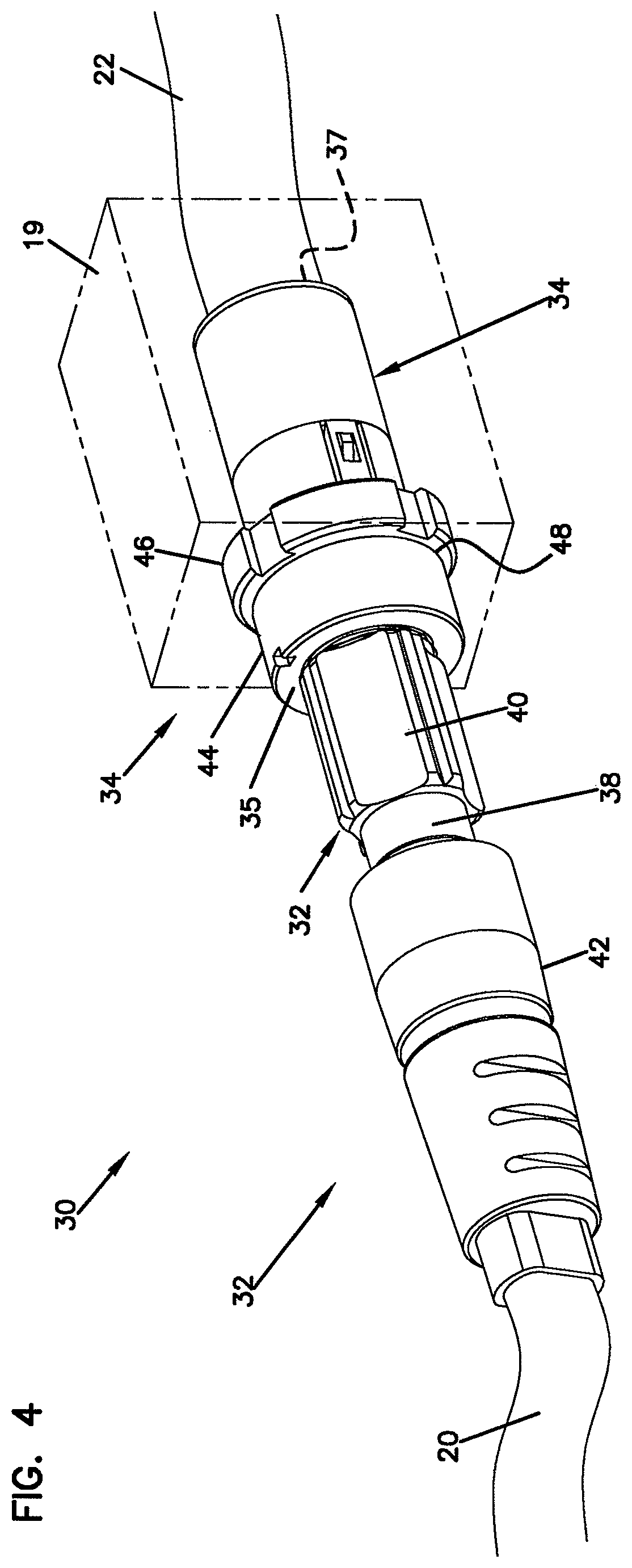
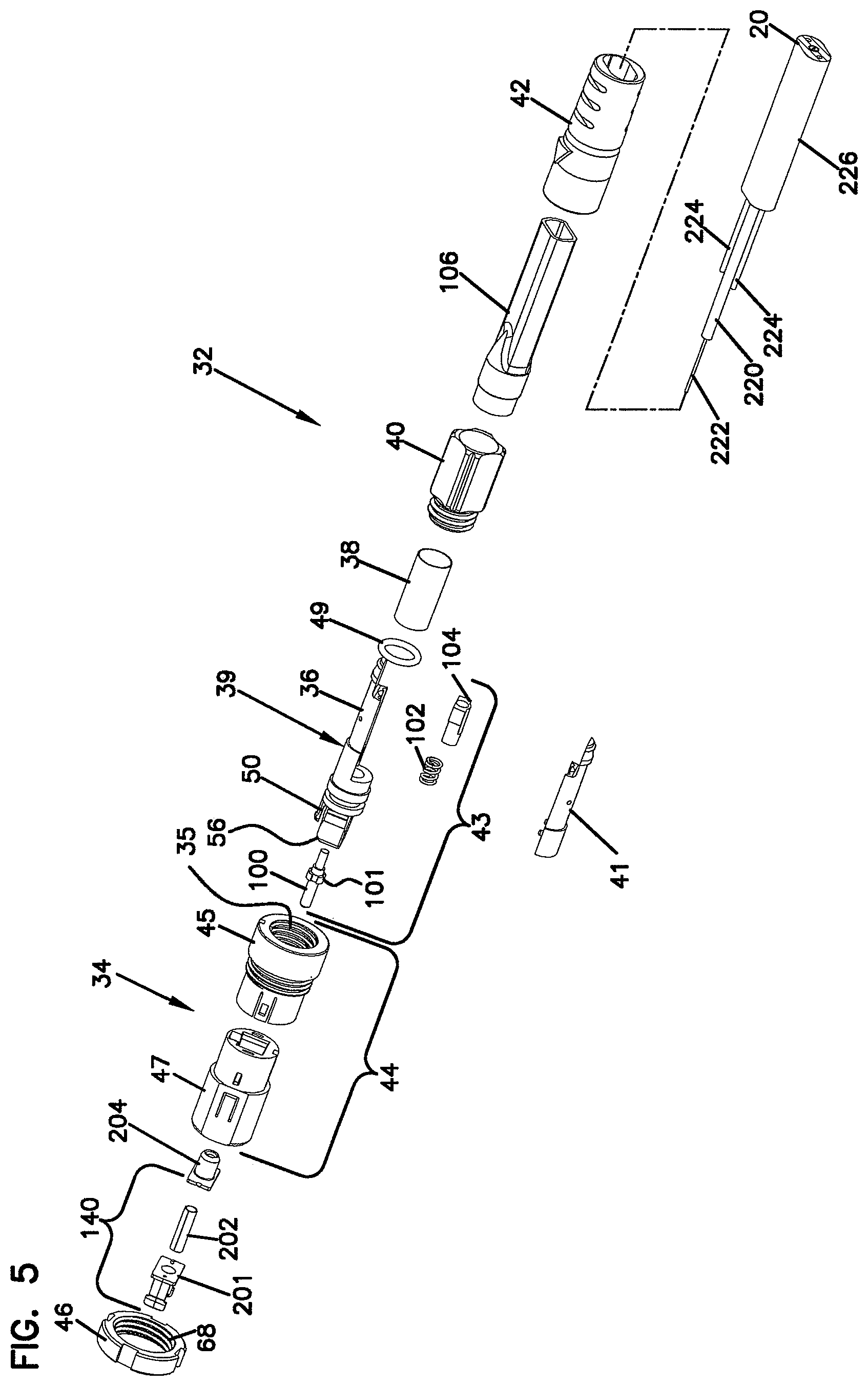
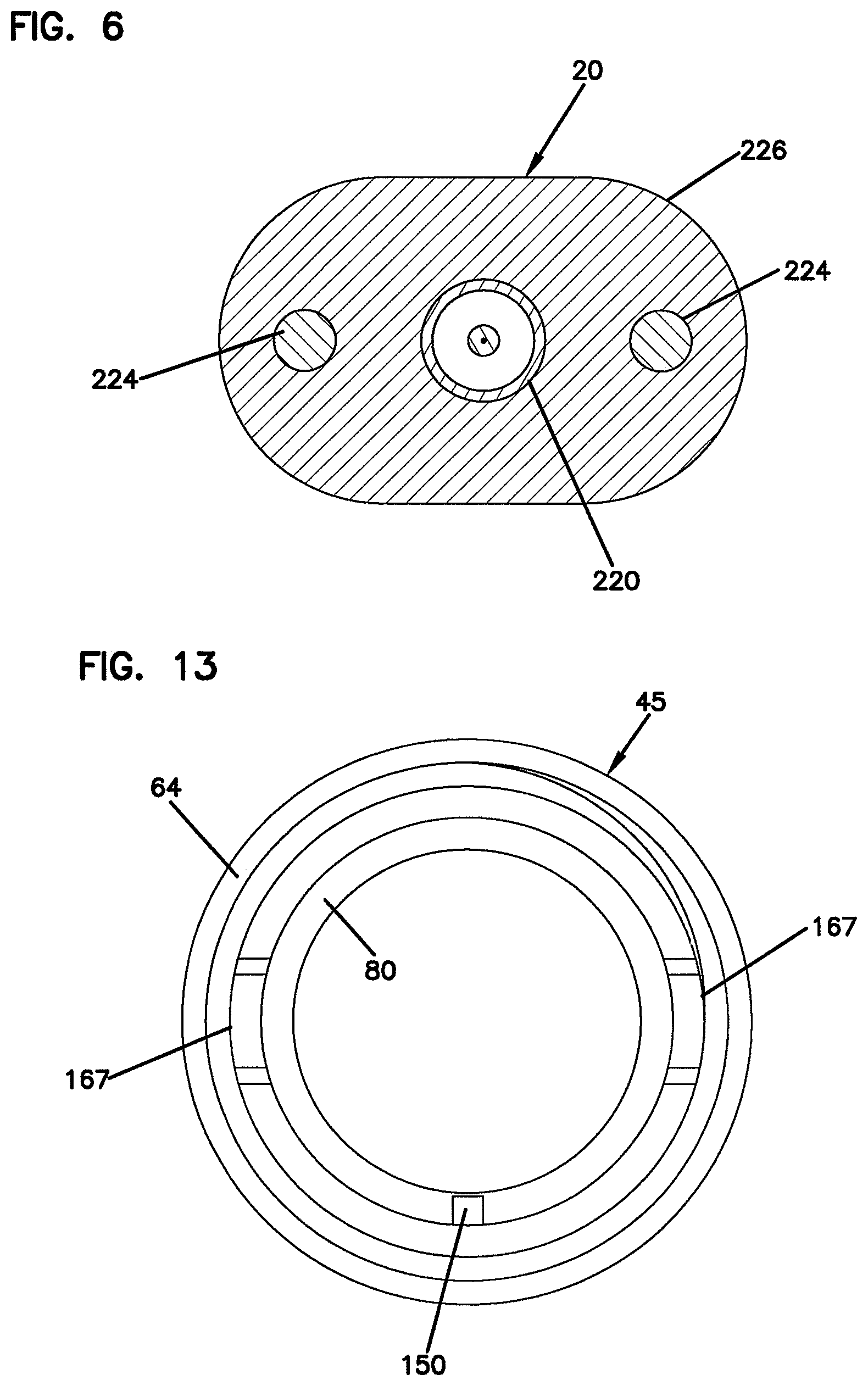
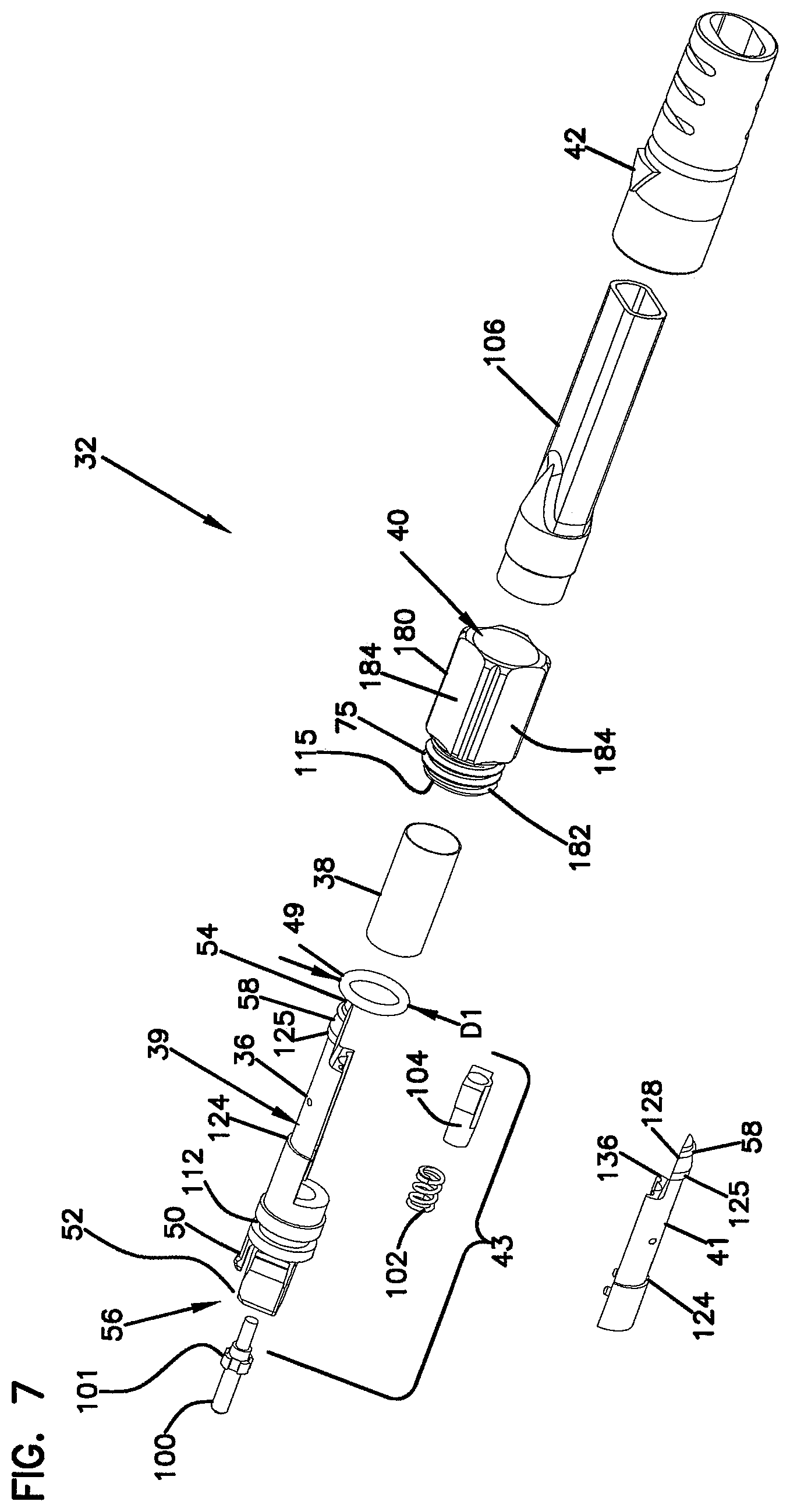
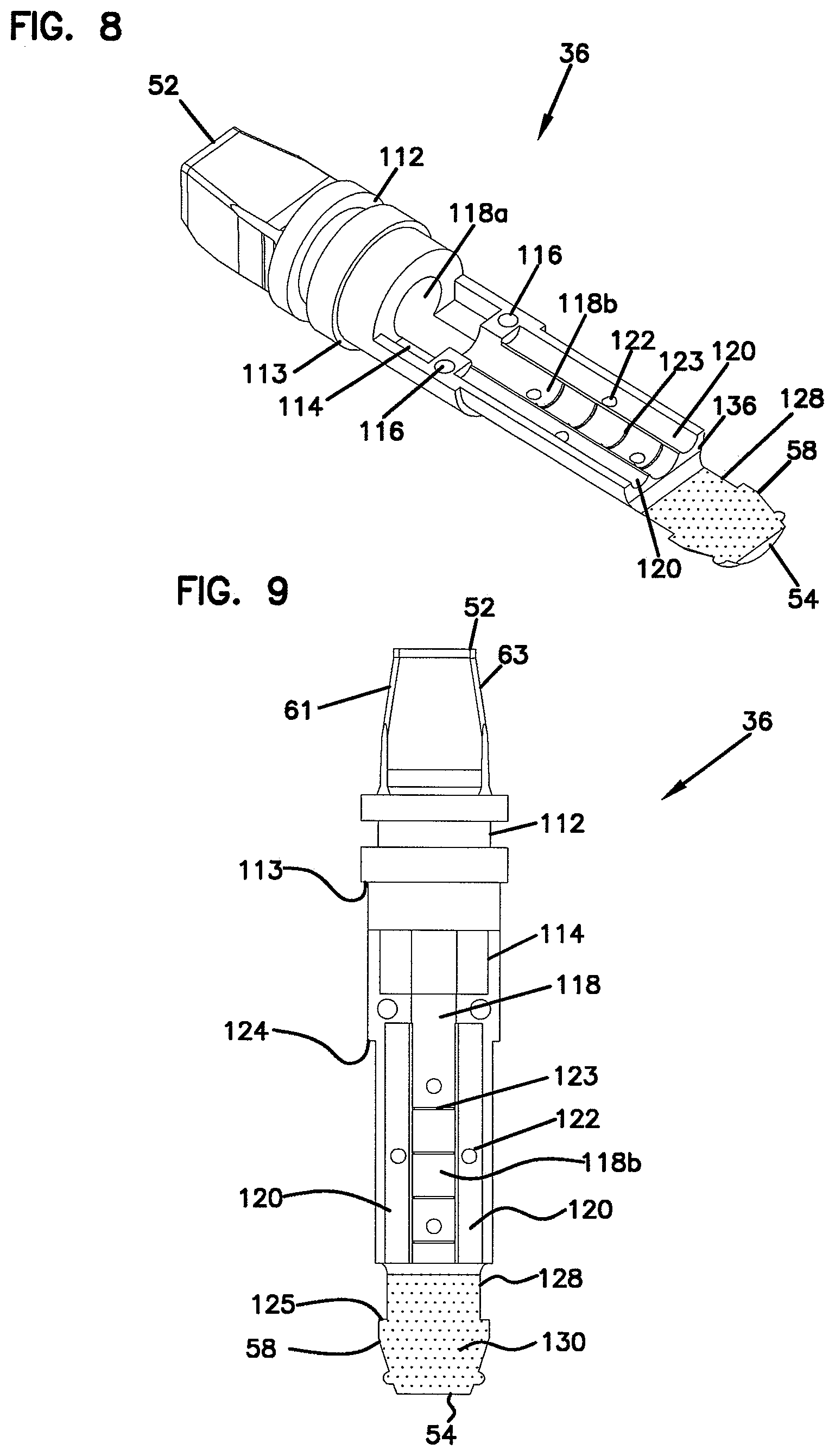
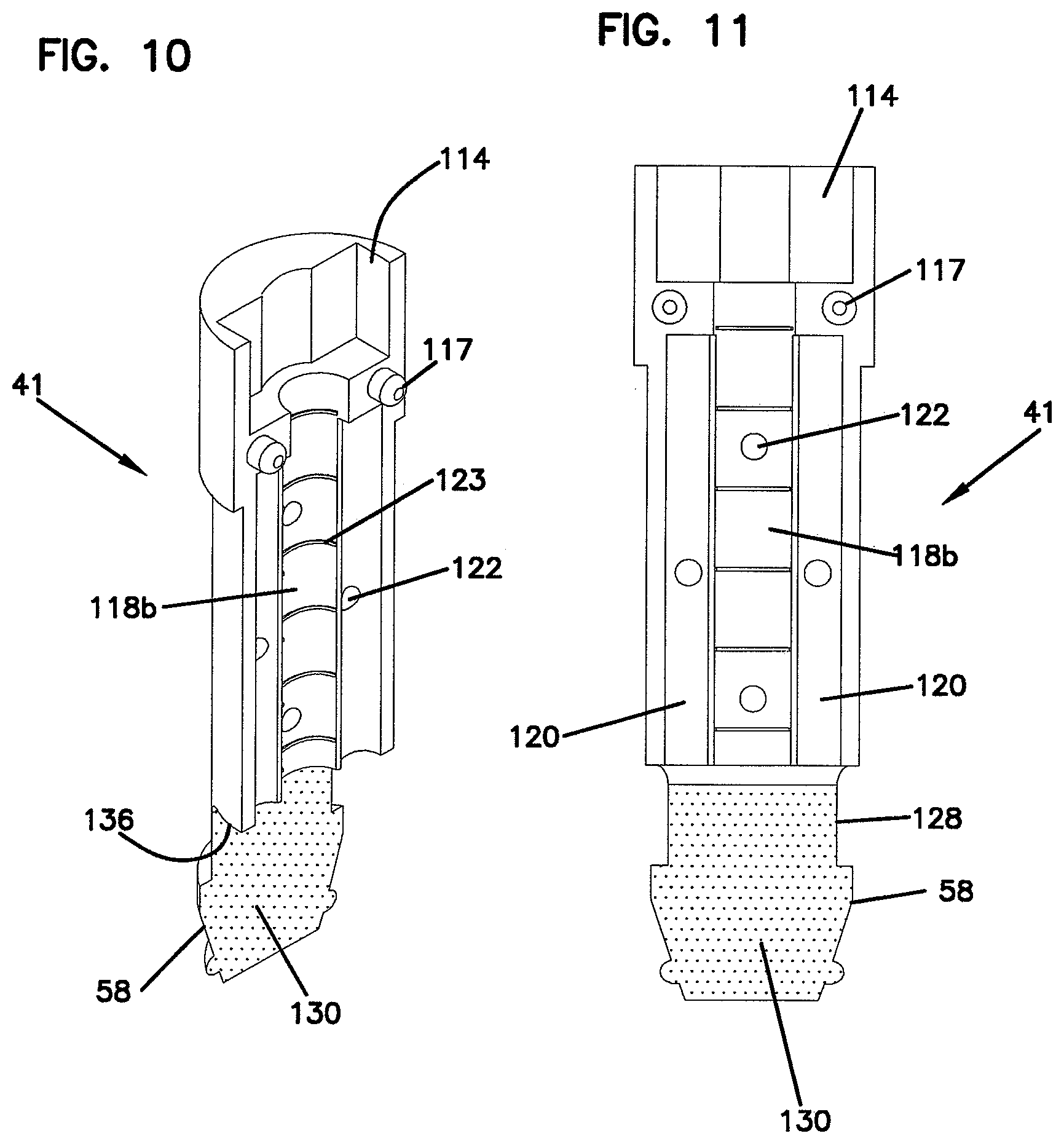
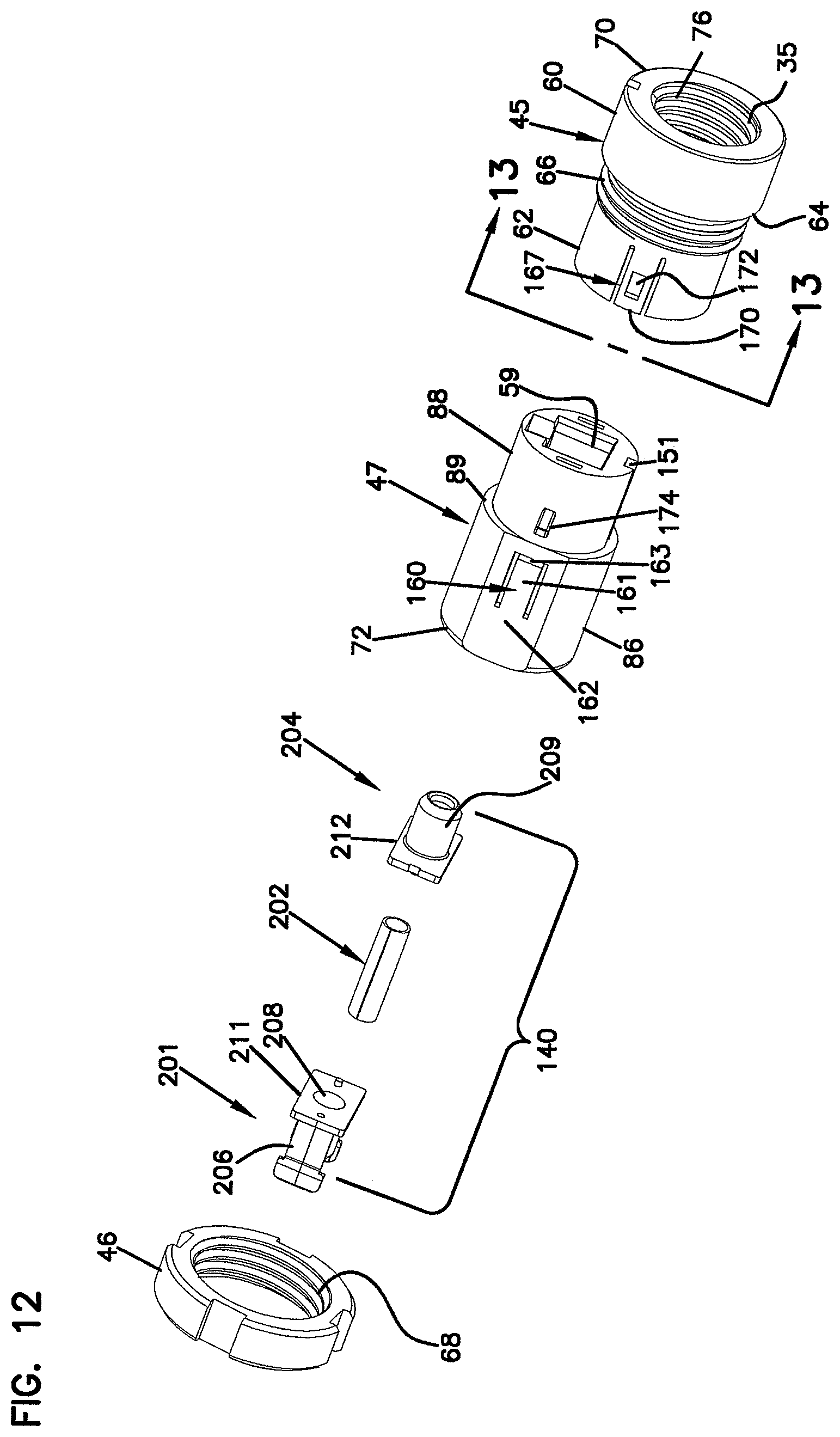
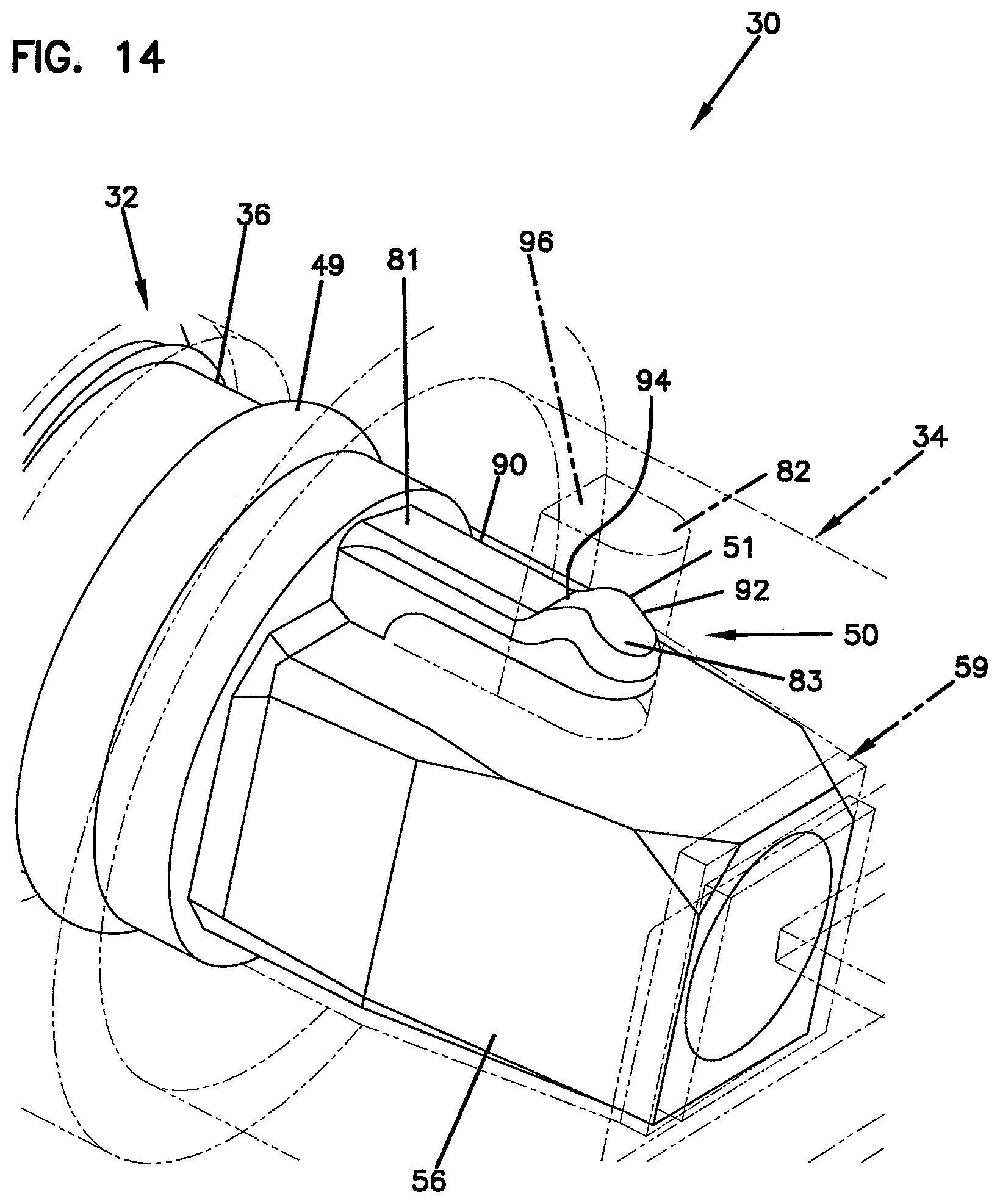
View All Diagrams
| United States Patent | 10,877,224 |
| Lu , et al. | December 29, 2020 |
Fiber optic adapter
Abstract
The present disclosure relates to a fiber optic connector for use with a fiber optic adapter. The fiber optic connector includes a connector housing having an end defining a plug portion. A ferrule assembly is mounted at least partially within the connector housing. The ferrule assembly includes a ferrule located at the plug portion of the connector housing. A sealing member is mounted about an exterior of the connector housing for providing a seal between the connector housing and the adapter. The fiber optic connector further includes first and second separate retaining mechanism for retaining the fiber optic connector within the fiber optic adapter.
| Inventors: | Lu; Yu (Eden Prairie, MN), Reagan; Randy (Morristown, NJ) | ||||||||||
|---|---|---|---|---|---|---|---|---|---|---|---|
| Applicant: |
|
||||||||||
| Assignee: | COMMSCOPE TECHNOLOGIES LLC
(Hickory, NC) |
||||||||||
| Family ID: | 1000005269345 | ||||||||||
| Appl. No.: | 16/402,472 | ||||||||||
| Filed: | May 3, 2019 |
Prior Publication Data
| Document Identifier | Publication Date | |
|---|---|---|
| US 20190324217 A1 | Oct 24, 2019 | |
Related U.S. Patent Documents
| Application Number | Filing Date | Patent Number | Issue Date | ||
|---|---|---|---|---|---|
| 15498697 | Apr 27, 2017 | 10338323 | |||
| 14323135 | May 30, 2017 | 9664862 | |||
| 12333509 | Jul 8, 2014 | 8770862 | |||
| 11657402 | Aug 11, 2009 | 7572065 | |||
| Current U.S. Class: | 1/1 |
| Current CPC Class: | G02B 6/3825 (20130101); G02B 6/3816 (20130101); G02B 6/3894 (20130101); G02B 6/3887 (20130101); G02B 6/3821 (20130101); G02B 6/3869 (20130101); G02B 6/3879 (20130101); G02B 6/3877 (20130101); G02B 6/3893 (20130101) |
| Current International Class: | G02B 6/38 (20060101) |
References Cited [Referenced By]
U.S. Patent Documents
| 2950338 | August 1960 | Taylor |
| 4140366 | February 1979 | Makuch et al. |
| 4140367 | February 1979 | Makuch et al. |
| 4142776 | March 1979 | Cherin et al. |
| 4174882 | November 1979 | McCartney |
| 4225214 | September 1980 | Hodge et al. |
| 4279467 | July 1981 | Borsuk et al. |
| 4291943 | September 1981 | Binek et al. |
| 4339171 | July 1982 | Makuch et al. |
| 4354731 | October 1982 | Mouissie |
| 4447120 | May 1984 | Borsuk |
| 4448478 | May 1984 | Matthews |
| 4515434 | May 1985 | Margolin et al. |
| 4611887 | September 1986 | Glover et al. |
| 4615581 | October 1986 | Morimoto |
| 4648688 | March 1987 | Ashman et al. |
| 4684205 | August 1987 | Margolin et al. |
| 4687291 | August 1987 | Stape et al. |
| 4705352 | November 1987 | Margolin et al. |
| 4715675 | December 1987 | Kevern et al. |
| 4725120 | February 1988 | Parzygnat |
| 4787706 | November 1988 | Cannon, Jr. et al. |
| 4793683 | December 1988 | Cannon, Jr. et al. |
| 4805980 | February 1989 | Mackenroth |
| 4815810 | March 1989 | Betzler et al. |
| 4820185 | April 1989 | Moulin |
| 4846564 | July 1989 | Caron et al. |
| 4854664 | August 1989 | McCartney |
| 4902238 | February 1990 | Iacobucci |
| 4907853 | March 1990 | Hiratsuka |
| 4961623 | October 1990 | Midkiff et al. |
| 4964688 | October 1990 | Caldwell et al. |
| 4974925 | December 1990 | Troutman et al. |
| 4979792 | December 1990 | Weber et al. |
| 5016968 | May 1991 | Hammond et al. |
| 5042901 | August 1991 | Merriken et al. |
| 5076656 | December 1991 | Briggs et al. |
| 5096276 | March 1992 | Gerace et al. |
| 5101463 | March 1992 | Cubukciyan et al. |
| 5104242 | April 1992 | Ishikawa |
| 5121458 | June 1992 | Nilsson et al. |
| 5123071 | June 1992 | Mulholland et al. |
| 5129023 | July 1992 | Anderson et al. |
| 5134677 | July 1992 | Leung et al. |
| 5136672 | August 1992 | Mulholland et al. |
| 5142601 | August 1992 | Shibata et al. |
| 5157749 | October 1992 | Briggs et al. |
| 5166995 | November 1992 | Briggs et al. |
| 5202942 | April 1993 | Collins et al. |
| 5210810 | May 1993 | Darden et al. |
| 5212752 | May 1993 | Stephenson et al. |
| 5214731 | May 1993 | Chang et al. |
| 5214732 | May 1993 | Beard et al. |
| 5214830 | June 1993 | Rozycki |
| 5222169 | June 1993 | Chang et al. |
| 5259052 | November 1993 | Briggs et al. |
| 5263105 | November 1993 | Johnson et al. |
| 5265181 | November 1993 | Chang |
| 5267342 | November 1993 | Takahashi et al. |
| 5268982 | December 1993 | Schaffer et al. |
| 5271080 | December 1993 | Hopper et al. |
| 5274729 | December 1993 | King et al. |
| 5276750 | January 1994 | Manning |
| 5282853 | February 1994 | Szegda |
| 5283848 | February 1994 | Abendschein et al. |
| 5293581 | March 1994 | DiMarco |
| 5293582 | March 1994 | Beard et al. |
| 5313540 | May 1994 | Ueda et al. |
| 5315679 | May 1994 | Baldwin et al. |
| 5317663 | May 1994 | Beard et al. |
| 5359688 | October 1994 | Underwood |
| 5363459 | November 1994 | Hultermans |
| 5367594 | November 1994 | Essert et al. |
| 5390270 | February 1995 | Hanzawa et al. |
| 5392373 | February 1995 | Essert |
| 5394497 | February 1995 | Erdman et al. |
| 5408557 | April 1995 | Hsu |
| 5418874 | May 1995 | Carlisle et al. |
| 5428703 | June 1995 | Lee |
| 5450517 | September 1995 | Essert |
| 5465313 | November 1995 | Belenkiy et al. |
| 5475782 | December 1995 | Ziebol |
| 5481634 | January 1996 | Anderson et al. |
| 5548677 | August 1996 | Kakii et al. |
| 5569050 | October 1996 | Lloyd |
| 5577145 | November 1996 | Musk |
| 5590229 | December 1996 | Goldman et al. |
| 5633970 | May 1997 | Olson et al. |
| 5636306 | June 1997 | Mock et al. |
| 5638474 | June 1997 | Lampert et al. |
| 5668906 | September 1997 | Yamamura et al. |
| 5680494 | October 1997 | Kaas |
| 5682450 | October 1997 | Patterson et al. |
| 5682451 | October 1997 | Lee et al. |
| 5715342 | February 1998 | Nodfelt et al. |
| 5732174 | March 1998 | Carpenter et al. |
| 5751874 | May 1998 | Chudoba |
| 5778122 | July 1998 | Glebel et al. |
| 5806175 | September 1998 | Underwood |
| 5809192 | September 1998 | Manning et al. |
| 5862289 | January 1999 | Walter et al. |
| 5887095 | March 1999 | Nagase |
| 5892870 | April 1999 | Fingler et al. |
| 5896477 | April 1999 | Stephenson et al. |
| 5905832 | May 1999 | Afille et al. |
| 5909526 | June 1999 | Roth et al. |
| 5920669 | July 1999 | Knecht et al. |
| 5923804 | July 1999 | Rosson |
| 5923805 | July 1999 | Anderson et al. |
| 5940559 | August 1999 | Noll |
| 5946436 | August 1999 | Takashi |
| 5971625 | October 1999 | Lu |
| 5980118 | November 1999 | Henningsson et al. |
| 5984532 | November 1999 | Tamaki et al. |
| 5993070 | November 1999 | Tamekuni et al. |
| 5993071 | November 1999 | Hultermans |
| 6022150 | February 2000 | Erdman et al. |
| 6079881 | June 2000 | Roth |
| 6149313 | November 2000 | Giebel et al. |
| 6149451 | November 2000 | Weber |
| 6151432 | November 2000 | Nakajima et al. |
| RE37028 | January 2001 | Cooke et al. |
| 6173097 | January 2001 | Throckmorton et al. |
| 6178283 | January 2001 | Weigel |
| 6179475 | January 2001 | Takamatsu et al. |
| 6179482 | January 2001 | Takizawa et al. |
| 6186670 | February 2001 | Austin et al. |
| 6188822 | February 2001 | McAlpine et al. |
| RE37079 | March 2001 | Stephenson et al. |
| RE37080 | March 2001 | Stephenson et al. |
| 6206579 | March 2001 | Selfridge et al. |
| 6224270 | May 2001 | Nakajima et al. |
| 6234683 | May 2001 | Waldron et al. |
| 6234685 | May 2001 | Carlisle et al. |
| 6254278 | July 2001 | Andrews et al. |
| 6261006 | July 2001 | Selfridge |
| 6264374 | July 2001 | Selfridge et al. |
| 6298190 | October 2001 | Waldron et al. |
| 6302594 | October 2001 | Lee |
| 6305849 | October 2001 | Roehrs et al. |
| 6347888 | February 2002 | Puetz |
| 6350063 | February 2002 | Gilliland et al. |
| 6357929 | March 2002 | Roehrs et al. |
| 6371660 | April 2002 | Roehrs et al. |
| 6379054 | April 2002 | Throckmorton et al. |
| 6419399 | July 2002 | Loder et al. |
| 6419402 | July 2002 | Zimmel |
| 6422764 | July 2002 | Marrs |
| 6427035 | July 2002 | Mahony |
| 6428215 | August 2002 | Nault |
| 6431783 | August 2002 | Nakajima et al. |
| 6435732 | August 2002 | Asao et al. |
| 6461057 | October 2002 | Chen |
| 6466725 | October 2002 | Battey et al. |
| 6496641 | December 2002 | Mahony |
| 6508594 | January 2003 | Bruland |
| 6522804 | February 2003 | Mahony |
| 6539147 | March 2003 | Mahony |
| 6540410 | April 2003 | Childers et al. |
| 6542674 | April 2003 | Gimblet |
| 6546175 | April 2003 | Wagman et al. |
| 6550977 | April 2003 | Hizuka |
| 6568861 | May 2003 | Benner et al. |
| 6575640 | June 2003 | Connelly et al. |
| 6579014 | June 2003 | Melton et al. |
| 6599026 | July 2003 | Fahrnbauer et al. |
| 6614980 | September 2003 | Mahony et al. |
| 6619697 | September 2003 | Griffioen et al. |
| 6619859 | September 2003 | Minamino et al. |
| 6625375 | September 2003 | Mahoney |
| 6629782 | October 2003 | McPhee et al. |
| 6648520 | November 2003 | McDonald et al. |
| 6652156 | November 2003 | Shinagawa et al. |
| 6655851 | December 2003 | Lee |
| 6663292 | December 2003 | Shirakawa |
| 6668127 | December 2003 | Mahoney |
| 6672774 | January 2004 | Theuerkorn et al. |
| 6678448 | January 2004 | Moisel et al. |
| 6685361 | February 2004 | Rubino et al. |
| 6695489 | February 2004 | Nault |
| 6702478 | March 2004 | Inagaki et al. |
| 6705764 | March 2004 | Shang |
| 6714710 | March 2004 | Gimblet |
| 6729773 | May 2004 | Finona et al. |
| 6738555 | May 2004 | Cooke et al. |
| 6739759 | May 2004 | Seeley |
| 6767141 | July 2004 | Dudek et al. |
| 6783281 | August 2004 | Cheng |
| 6785450 | August 2004 | Wagman et al. |
| 6789950 | September 2004 | Loder et al. |
| 6809265 | October 2004 | Gladd et al. |
| 6816662 | November 2004 | Doss et al. |
| 6817902 | November 2004 | Bernardi et al. |
| 6821024 | November 2004 | Bates, III |
| 6832856 | December 2004 | Chiu et al. |
| 6848836 | February 2005 | Ueda et al. |
| 6854895 | February 2005 | Coffey et al. |
| 6863446 | March 2005 | Ng |
| 6899467 | May 2005 | McDonald et al. |
| 6909821 | June 2005 | Ravasio et al. |
| 6916120 | July 2005 | Zimmel et al. |
| 6918703 | July 2005 | Chen et al. |
| 6918704 | July 2005 | Marrs et al. |
| 6962445 | November 2005 | Zimmel et al. |
| 6974265 | December 2005 | Chiu et al. |
| 7008116 | March 2006 | Kobayashi et al. |
| 7011454 | March 2006 | Caveney et al. |
| 7025507 | April 2006 | de Marchi |
| 7035513 | April 2006 | Mohler et al. |
| 7044650 | May 2006 | Tran et al. |
| 7050692 | May 2006 | Harlan et al. |
| 7074066 | July 2006 | Pepe |
| 7076144 | July 2006 | Loder et al. |
| 7079734 | July 2006 | Seddon et al. |
| 7090406 | August 2006 | Melton et al. |
| 7090407 | August 2006 | Melton et al. |
| 7093983 | August 2006 | Taira et al. |
| 7111990 | September 2006 | Melton et al. |
| 7113679 | September 2006 | Melton et al. |
| 7114857 | October 2006 | Kayner et al. |
| 7121731 | October 2006 | Weynant et al. |
| 7121732 | October 2006 | Pimpinella et al. |
| 7137742 | November 2006 | Theuerkorn et al. |
| 7146090 | December 2006 | Vo et al. |
| 7150567 | December 2006 | Luther et al. |
| 7165893 | January 2007 | Schmitz |
| 7175352 | February 2007 | De Marchi |
| 7178990 | February 2007 | Caveney et al. |
| 7182522 | February 2007 | Sasaki et al. |
| 7184634 | February 2007 | Hurley et al. |
| 7201518 | April 2007 | Holmquist |
| 7204644 | April 2007 | Barnes et al. |
| 7206482 | April 2007 | Rhyne et al. |
| 7207727 | April 2007 | Tran et al. |
| 7210855 | May 2007 | Rossi et al. |
| 7213975 | May 2007 | Khemakhem et al. |
| 7220061 | May 2007 | De Marchi |
| 7228047 | June 2007 | Szilagyi et al. |
| 7234875 | June 2007 | Krowiak et al. |
| 7234876 | June 2007 | Ohtsu et al. |
| 7234877 | June 2007 | Sedor |
| 7239812 | July 2007 | Hung et al. |
| 7244066 | July 2007 | Theuerkorn |
| 7255486 | August 2007 | Cox et al. |
| 7255490 | August 2007 | Zhang et al. |
| 7264401 | September 2007 | Johnson |
| 7264402 | September 2007 | Theuerkorn et al. |
| 7278791 | October 2007 | Demaret et al. |
| 7281856 | October 2007 | Grzegorzewska et al. |
| 7290941 | November 2007 | Kiani et al. |
| 7292763 | November 2007 | Smith et al. |
| 7302152 | November 2007 | Luther et al. |
| 7317863 | January 2008 | Lu et al. |
| 7326087 | February 2008 | Gerlach et al. |
| 7331719 | February 2008 | Manning et al. |
| RE40150 | March 2008 | Ishibashi et al. |
| 7346256 | March 2008 | Marrs et al. |
| 7347627 | March 2008 | Saito et al. |
| 7369738 | May 2008 | Larson et al. |
| 7371014 | May 2008 | Willis et al. |
| 7380992 | June 2008 | Kramer et al. |
| 7460750 | December 2008 | Durrant et al. |
| 7463803 | December 2008 | Cody et al. |
| 7467896 | December 2008 | Melton et al. |
| 7481585 | January 2009 | Scadden et al. |
| 7572065 | August 2009 | Lu et al. |
| 7591595 | September 2009 | Lu et al. |
| 7614797 | November 2009 | Lu et al. |
| 7677814 | March 2010 | Lu et al. |
| 7686519 | March 2010 | Lu |
| 7722258 | May 2010 | Lu et al. |
| 7744286 | June 2010 | Lu et al. |
| 7744288 | June 2010 | Lu et al. |
| 7762726 | July 2010 | Lu et al. |
| 7942590 | May 2011 | Lu et al. |
| 7959361 | June 2011 | Lu et al. |
| RE42522 | July 2011 | Zimmel et al. |
| 8135256 | March 2012 | Solheid et al. |
| 8202008 | June 2012 | Lu et al. |
| 8414196 | April 2013 | Lu et al. |
| 8770862 | July 2014 | Lu et al. |
| 8808842 | August 2014 | Avazzeri et al. |
| 9664862 | May 2017 | Lu et al. |
| 10289523 | May 2019 | Burton et al. |
| 2001/0012428 | August 2001 | Nakajima et al. |
| 2001/0036345 | November 2001 | Gimblet et al. |
| 2002/0022392 | February 2002 | Below et al. |
| 2002/0062978 | May 2002 | Sakabe et al. |
| 2002/0081077 | June 2002 | Nault |
| 2002/0164130 | November 2002 | Elkins, II et al. |
| 2003/0063867 | April 2003 | McDonald et al. |
| 2003/0081905 | May 2003 | Bethea et al. |
| 2003/0094298 | May 2003 | Morrow et al. |
| 2003/0095754 | May 2003 | Matsumoto et al. |
| 2003/0095780 | May 2003 | Chang |
| 2004/0017983 | January 2004 | Chen et al. |
| 2004/0033028 | February 2004 | Cheng |
| 2004/0038588 | February 2004 | Bernardi et al. |
| 2004/0047566 | March 2004 | McDonald et al. |
| 2004/0120663 | June 2004 | Lail et al. |
| 2004/0223699 | November 2004 | Melton et al. |
| 2004/0223720 | November 2004 | Melton et al. |
| 2004/0228589 | November 2004 | Melton et al. |
| 2005/0041928 | February 2005 | Zimmel et al. |
| 2005/0064752 | March 2005 | Serino |
| 2005/0100286 | May 2005 | Cox |
| 2005/0117850 | June 2005 | Milette |
| 2005/0215101 | September 2005 | Pepe |
| 2005/0232553 | October 2005 | Holmquist |
| 2005/0254757 | November 2005 | Ferretti, III et al. |
| 2006/0056769 | March 2006 | Khemakhem et al. |
| 2006/0088247 | April 2006 | Tran et al. |
| 2006/0088248 | April 2006 | Tran et al. |
| 2006/0089049 | April 2006 | Sedor |
| 2006/0115219 | June 2006 | Mudd et al. |
| 2006/0193562 | August 2006 | Theuerkorn |
| 2007/0014522 | January 2007 | Yamaguchi et al. |
| 2007/0025665 | February 2007 | Dean, Jr. et al. |
| 2007/0077010 | April 2007 | Melton et al. |
| 2007/0127873 | June 2007 | Manning et al. |
| 2007/0196053 | August 2007 | Kewitsch |
| 2008/0044137 | February 2008 | Luther et al. |
| 2008/0131132 | June 2008 | Solheid et al. |
| 2008/0175541 | July 2008 | Lu et al. |
| 2008/0175542 | July 2008 | Lu et al. |
| 2008/0175546 | July 2008 | Lu et al. |
| 2008/0273840 | November 2008 | Lu et al. |
| 2008/0310796 | December 2008 | Lu |
| 2009/0003772 | January 2009 | Lu et al. |
| 2009/0041411 | February 2009 | Melton et al. |
| 2009/0060423 | March 2009 | Melton et al. |
| 2009/0148101 | June 2009 | Lu et al. |
| 2009/0148102 | June 2009 | Lu et al. |
| 2009/0148103 | June 2009 | Lu et al. |
| 2009/0148104 | June 2009 | Lu et al. |
| 2009/0162016 | June 2009 | Lu et al. |
| 2010/0034502 | February 2010 | Lu et al. |
| 2010/0035075 | February 2010 | Avazzeri et al. |
| 2010/0266242 | October 2010 | Lu et al. |
| 2010/0266244 | October 2010 | Lu et al. |
| 2010/0290741 | November 2010 | Lu et al. |
| 2012/0011514 | January 2012 | Burton et al. |
| 2014/0133804 | May 2014 | Lu et al. |
| 2014/0314379 | November 2014 | Lu et al. |
| 3537684 | Apr 1987 | DE | |||
| 102004049697 | Apr 2006 | DE | |||
| 0156075 | Oct 1985 | EP | |||
| 0345519 | Dec 1989 | EP | |||
| 0547778 | Jun 1993 | EP | |||
| 0581527 | Feb 1994 | EP | |||
| 0689069 | Dec 1995 | EP | |||
| 0468671 | Jan 1996 | EP | |||
| 0762171 | Mar 1997 | EP | |||
| 0848267 | Jun 1998 | EP | |||
| 0855610 | Jul 1998 | EP | |||
| 0856761 | Aug 1998 | EP | |||
| 0940700 | Sep 1999 | EP | |||
| 0949522 | Oct 1999 | EP | |||
| 0997757 | May 2000 | EP | |||
| 1065542 | Jan 2001 | EP | |||
| 1258758 | Nov 2002 | EP | |||
| 1333537 | Aug 2003 | EP | |||
| 1457793 | Sep 2004 | EP | |||
| 1566674 | Aug 2005 | EP | |||
| 2154333 | Sep 1985 | GB | |||
| 5230447 | Mar 1977 | JP | |||
| 58142308 | Aug 1983 | JP | |||
| 6254204 | Mar 1987 | JP | |||
| 444607 | Apr 1992 | JP | |||
| 5106765 | Apr 1993 | JP | |||
| 862432 | Mar 1996 | JP | |||
| 9135526 | May 1997 | JP | |||
| 9159867 | Jun 1997 | JP | |||
| 10160969 | Jun 1998 | JP | |||
| 11160579 | Jun 1999 | JP | |||
| 2000292653 | Oct 2000 | JP | |||
| 2001116968 | Apr 2001 | JP | |||
| 2003195103 | Jul 2003 | JP | |||
| 2005114860 | Apr 2005 | JP | |||
| 2006146084 | Jun 2006 | JP | |||
| 9415232 | Jul 1994 | WO | |||
| 9425885 | Nov 1994 | WO | |||
| 0031575 | Jun 2000 | WO | |||
| 0127660 | Apr 2001 | WO | |||
| 0192937 | Dec 2001 | WO | |||
| 03073819 | Sep 2003 | WO | |||
| 2005072395 | Aug 2005 | WO | |||
| 2005101078 | Oct 2005 | WO | |||
| 2006098734 | Sep 2006 | WO | |||
Other References
|
Office Action, EP 08 728 121.8, dated May 25, 2012, 6 pages. cited by applicant . European Search Report, EP 15 19 0694, dated Mar. 29, 2016, 7 pages. cited by applicant . European Search Report, EP 12 19 4278.3, dated Dec. 20, 2012, 6 pages. cited by applicant . Office Action, EP 12 19 4278.3, dated Sep. 30, 2013, 5 pages. cited by applicant . Delphi Connection Systems, "Harsh Environment Hermaphroditic Fiber Optic Connectors," 16 pages ( .COPYRGT. 2002). cited by applicant . International Search Report and Written Opinion cited in PCT/US2008/051782 dated Aug. 18, 2008. cited by applicant . Invitation to Pay Additional Fees with Partial International Search cited in PCT/US2008/051782 dated Jun. 25, 2008. cited by applicant . Mikon Series ST-III Multimode and Singlemode Connectors, 2 pages (Publicly known at least as early as Jan. 2, 1992). cited by applicant . Opti Tap.TM. Connector. An Evolant Solutions Product, 2 pages (Sep. 2005). cited by applicant . Patent Examination Report No. 1, Australian Patent Office, Patent Application No. 2008207974, Oct. 17, 2012, 6 pp. cited by applicant . Patent Examination Report No. 2, Australian Patent Office, Patent Application No. 2008207974, Aug. 1, 2013, 10 pp. cited by applicant . Stratos Lightwave.TM. Brochure, "HDLC Hermaphroditic Butt Joint Connector," 2 pages (known as prior art at least as early as Sep. 8, 2003). cited by applicant . Stratos Lightwave.TM. Brochure, "HQLC Hermaphroditic Butt Joint Connector," 2 pages (known as prior art at least as early as Sep. 8, 2003). cited by applicant . Examination Report, Australian Application No. 2019203886, dated Apr. 16, 2020, 3 pages. cited by applicant. |
Primary Examiner: Bedtelyon; John
Attorney, Agent or Firm: Merchant & Gould P.C.
Parent Case Text
CROSS REFERENCE TO RELATED APPLICATIONS
This application is a continuation of U.S. application Ser. No. 15/498,697, filed on Apr. 27, 2017, now U.S. Pat. No. 10/338,323, issued on Jul. 2, 2019, titled HARDENED FIBER OPTIC CONNECTOR, which is a continuation of U.S. application Ser. No. 14/323,135, filed on Jul. 3, 2014, now U.S. Pat. No. 9,664,862, issued on May 30, 2017, titled HARDENED FIBER OPTIC CONNECTOR, which is a continuation of U.S. application Ser. No. 12/333,509, filed on Dec. 12, 2008, now U.S. Pat. No. 8,770,862, issued on Jul. 8, 2014, titled HARDENED FIBER OPTIC CONNECTOR, which is a continuation of U.S. application Ser. No. 11/657,402, filed on Jan. 24, 2007, now U.S. Pat. No. 7,572,065, issued on Aug. 11, 2009, titled HARDENED FIBER OPTIC CONNECTOR, the disclosures of which are hereby incorporated by reference in their entireties.
Claims
What is claimed is:
1. A fiber optic adapter comprising: an outer housing having a first axial end portion defining a first adapter port and a second axial end portion defining a second adapter port; an adapter assembly mounted within the outer housing in a manner that prohibits the adapter assembly from floating within the outer housing, the adapter assembly including a split sleeve adapted to receive a ferrule of a first fiber optic connector inserted into the first adapter port and a ferrule of a second fiber optic connector inserted into the second adapter port and to maintain alignment between fibers of the first and second fiber optic connectors; and a coupler adapted to rotatably mount around an exterior of the outer housing and to mechanically connect the fiber optic adapter to a structure, wherein the coupler is a mounting nut that rotates around the outer housing to engage or disengage the structure.
2. The fiber optic adapter of claim 1, wherein the outer housing defines a shoulder, and the coupler is structured to capture the structure between the shoulder and the coupler to secure the fiber optic adapter to the structure.
3. The fiber optic adapter of claim 1, wherein the structure is an enclosure wall.
4. The fiber optic adapter of claim 1, wherein the first axial end portion includes a twist-to-lock fastening element to secure the first fiber optic connector in the first adapter port.
5. The fiber optic adapter of claim 1, wherein the first adapter port includes an annular sealing surface structured to engage a sealing member mounted around an exterior of the first fiber optic connector when the first fiber optic connector is inserted into the first adapter port.
6. The fiber optic adapter of claim 5, wherein the annular sealing surface is structured to provide an internal environmental seal between the fiber optic adapter and the first fiber optic connector when the first fiber optic connector is inserted into the first adapter port.
7. The fiber optic adapter of claim 5, wherein the first adapter port includes an angled diameter transition that decreases an internal diameter of the first adapter port to a diameter defined by the annular sealing surface.
8. The fiber optic adapter of claim 5, wherein the annular sealing surface defines a diameter less than or equal to 15 millimeters.
9. The fiber optic adapter of claim 5, wherein the annular sealing surface defines a diameter less than or equal to 12.5 millimeters.
10. The fiber optic adapter of claim 5, wherein the annular sealing surface defines a diameter less than or equal to 10 millimeters.
11. The fiber optic adapter of claim 1, wherein the adapter assembly is structured to snap-fit within the outer housing.
12. The fiber optic adapter of claim 1, wherein the outer housing includes oppositely positioned latches for securing the adapter assembly within the outer housing, wherein the oppositely positioned latches include retention tabs, and wherein the retention tabs prevent the adapter assembly from floating within the outer housing.
13. The fiber optic adapter of claim 1, wherein the adapter assembly includes a connector retention clip having a pair of latching arms that interlock with the second fiber optic connector when inserted within the second adapter port, and the connector retention clip further includes a cylindrical receptacle for receiving a first end of the split sleeve.
14. The fiber optic adapter of claim 13, wherein the adapter assembly further includes a backing piece having a cylindrical receptacle, and a second end of the split sleeve is received within the cylindrical receptacle of the backing piece.
15. The fiber optic adapter of claim 14, wherein the retention clip and the backing piece are secured together to retain the split sleeve between the retention clip and the backing piece, and wherein the split sleeve is mounted between the retention clip and the backing piece to float within the cylindrical receptacles of the retention clip and the backing piece to provide proper alignment between the ferrules of the first and second fiber optic connectors.
16. The fiber optic adapter of claim 1, wherein the second axial end portion includes a keying slot structured to receive an alignment structure of the second fiber optic connector to ensure that the second fiber optic connector is inserted into the second adapter port at a proper orientation.
17. The fiber optic adapter of claim 1, wherein the fiber optic adapter is ruggedized.
18. A fiber optic adapter comprising: an outer housing having a first axial end portion defining a first adapter port and a second axial end portion defining a second adapter port; an adapter assembly mounted within the outer housing in a manner that prohibits the adapter assembly from floating within the outer housing, the adapter assembly including a split sleeve adapted to receive a ferrule of a first fiber optic connector inserted into the first adapter port and a ferrule of a second fiber optic connector inserted into the second adapter port and to maintain alignment between fibers of the first and second fiber optic connectors; and a coupler adapted to rotatably mount around an exterior of the outer housing and to mechanically connect the fiber optic adapter to a structure; wherein the outer housing includes oppositely positioned latches for securing the adapter assembly within the outer housing, wherein the oppositely positioned latches include retention tabs that prevent the adapter assembly from floating within the outer housing.
19. A fiber optic adapter comprising: an outer housing having a first axial end portion defining a first adapter port and a second axial end portion defining a second adapter port; an adapter assembly mounted within the outer housing in a manner that prohibits the adapter assembly from floating within the outer housing, the adapter assembly including a split sleeve adapted to receive a ferrule of a first fiber optic connector inserted into the first adapter port and a ferrule of a second fiber optic connector inserted into the second adapter port and to maintain alignment between fibers of the first and second fiber optic connectors, the adapter assembly includes a connector retention clip having a pair of latching arms that interlock with the second fiber optic connector when inserted within the second adapter port, and the connector retention clip includes a cylindrical receptacle for receiving a first end of the split sleeve; and a coupler adapted to rotatably mount around an exterior of the outer housing and to mechanically connect the fiber optic adapter to a structure.
Description
TECHNICAL FIELD
The present disclosure relates to fiber optic data transmission, and more particularly to fiber optic cable connection systems.
BACKGROUND
Fiber optic cables are widely used to transmit light signals for high speed data transmission. A fiber optic cable typically includes: (1) an optical fiber or optical fibers; (2) a buffer or buffers that surrounds the fiber or fibers; (3) a strength layer that surrounds the buffer or buffers; and (4) an outer jacket. Optical fibers function to carry optical signals. A typical optical fiber includes an inner core surrounded by a cladding that is covered by a coating. Buffers (e.g., loose or tight buffer tubes) typically function to surround and protect coated optical fibers. Strength layers add mechanical strength to fiber optic cables to protect the internal optical fibers against stresses applied to the cables during installation and thereafter. Example strength layers include aramid yarn, steel and epoxy reinforced glass roving. Outer jackets provide protection against damage caused by crushing, abrasions, and other physical damage. Outer jackets also provide protection against chemical damage (e.g., ozone, alkali, acids).
Fiber optic cable connection systems are used to facilitate connecting and disconnecting fiber optic cables in the field without requiring a splice. A typical fiber optic cable connection system for interconnecting two fiber optic cables includes fiber optic connectors mounted at the ends of the fiber optic cables, and an adapter for mechanically and optically coupling the fiber optic connectors together. Fiber optic connectors generally include ferrules that support the ends of the optical fibers of the fiber optic cables. The end faces of the ferrules are typically polished and are often angled. The adapter includes co-axially aligned ports (i.e., receptacles) for receiving the fiber optic connectors desired to be interconnected. The adapter includes an internal sleeve that receives and aligns the ferrules of the fiber optic connectors when the connectors are inserted within the ports of the adapter. With the ferrules and their associated fibers aligned within the sleeve of the adapter, a fiber optic signal can pass from one fiber to the next. The adapter also typically has a mechanical fastening arrangement (e.g., a snap-fit arrangement) for mechanically retaining the fiber optic connectors within the adapter. One example of an existing fiber optic connection system is described in U.S. Pat. Nos. 6,579,014, 6,648,520, and 6,899,467.
SUMMARY OF THE DISCLOSURE
One aspect of the present disclosure relates to a fiber optic connector having a dual fastening arrangement for securing the fiber optic connector in a fiber optic adapter.
Another aspect of the present disclosure relates to a fiber optic connector that is adapted to provide relatively high fiber optic circuit densities at an enclosure.
A further aspect of the present disclosure relates to a fiber optic connector having a tapered interface adapted to complement a corresponding tapered interface of a fiber optic adapter.
A variety of additional inventive aspects will be set forth in the description that follows. The inventive aspects can relate to individual features and to combinations of features. It is to be understood that both the forgoing general description and the following detailed description are exemplary and explanatory only and are not restrictive of the broad inventive concepts upon which the embodiments disclosed herein are based.
BRIEF DESCRIPTION OF THE DRAWINGS
FIG. 1 is a perspective view of an example fiber optic connection system having features that are examples of inventive aspects in accordance with the principles of the present disclosure;
FIG. 2 is a perspective view of the fiber optic connection system of FIG. 1 with a connector of the fiber optic connection system terminating the end of a fiber optic cable;
FIG. 3 shows the fiber optic connection system of FIG. 1 with an adapter of the fiber optic connection system shown in phantom lines;
FIG. 4 shows the fiber optic connection system of FIG. 1 with an adapter of the fiber optic connection system mounted to a schematic enclosure;
FIG. 5 is an exploded, perspective view of the fiber optic connection system of FIG. 1;
FIG. 6 is a cross-sectional view taken along section line 6-6 of FIG. 5;
FIG. 7 is an exploded, perspective view of the fiber optic connector of the fiber optic connection system of FIG. 1;
FIG. 8 is a perspective view of a main body of the housing of the fiber optic connector of FIG. 7;
FIG. 9 is a plan view of the main body of FIG. 8;
FIG. 10 is a perspective view of a cover of the housing of the fiber optic connector of FIG. 7;
FIG. 11 is a plan view of the cover of FIG. 10;
FIG. 12 is an exploded, perspective view of a fiber optic adapter of the fiber optic connection system of FIG. 1;
FIG. 13 is a view taken along section line 13-13 of FIG. 12;
FIG. 14 is an enlarged view of a portion of FIG. 3;
FIG. 15 is an enlarged view of a latch provided on the fiber optic connector of the fiber optic connection system of FIG. 1;
FIG. 16 is a side view of the fiber optic connection system and fiber optic cable of FIG. 2;
FIG. 17 is a cross-sectional view taken along section line 17-17 of FIG. 16;
FIG. 18 is a top view of the fiber optic connection system and fiber optic cable of FIG. 2;
FIG. 19 is a cross-sectional view taken along section line 19-19 of FIG. 18;
FIG. 20 is a perspective view of another fiber optic connection system having features that are examples of inventive aspects in accordance with the principles of the present disclosure;
FIG. 21 is a top view of the fiber optic connection system of FIG. 20;
FIG. 22 is a cross-sectional view taken along section line 22-22 of FIG. 23; and
FIG. 23 is an end view of the fiber optic connection system of FIG. 20.
DETAILED DESCRIPTION
FIGS. 1-5 depict a fiber optic connection system 30 in accordance with the principles of the present disclosure for optically connecting a first fiber optic cable 20 (see FIG. 4) to a second fiber optic cable 22 (see FIG. 4). The fiber optic connection system 30 includes a fiber optic adapter 34, a first fiber optic connector 32 terminating the first cable 20, and a second fiber optic connector 33 (shown at FIG. 3) terminating the second fiber optic cable 22. The adapter 34 is depicted mounted to an enclosure 19 (shown schematically at FIG. 4). The adapter 34 includes a first port 35 for receiving the first connector 32 and a second port 37 for receiving the second connector 33. The first cable 20 is optically coupled to the second cable 22 when the connectors 32, 33 are positioned within their respective ports 35, 37 of the adapter 34.
As shown at FIG. 4, the first cable 20 is an external cable (e.g., an outside plant cable located outside the enclosure 19) and the second cable 22 is located inside the enclosure 19. In such an embodiment, the first cable 20 cable is adapted to carry an optical signal to the enclosure 19 and the fiber optic connection system 30 allows the signal to be transferred from the first cable 20 to the second cable 22.
The cables 20 and 22 each include one or more optical fibers capable of carrying optical signals. The optical fibers include a core surrounded by cladding. The core is the light-conducting central portion of an optical fiber. The cladding surrounds the core and is composed of a material having a lower index of refraction than the material of the core. Light is internally reflected within the core to transmit the optical signal along the core. The optical fibers can be protected within buffer tubes. The fiber optic cables also can include strength members within the fiber optic cables to increase the tensile strength of the fiber optic cables. The optical fibers, strength members, buffer tubes and other cable components can be surrounded by an outer jacket or sheath that provides a protective covering for cable components. As shown at FIG. 5, the first cable 20 includes a central buffer tube 220 containing at least one optical fiber 222. Strength members 224 are positioned on opposite sides of the central buffer tube 220. The strength members 224 and the buffer tube are positioned within an outer jacket 226 of the cable 20.
The enclosure 19 can include a wide variety of optical enclosures/housings (e.g., drop terminals, pedestals, network interface devices, fiber distribution hubs, splice enclosures, optical network terminals, etc.). In one embodiment, adapters 34 can be mounted to a drop terminal of the type disclosed at U.S. patent application Ser. No. 11/075,847, entitled Fiber Access Terminal, filed on Mar. 8, 2005, and that is hereby incorporated by reference in its entirety. For such embodiments, the cable 20 can be a drop cable routed to a subscriber premises and the cable 22 can be a connectorized fiber from a stub cable that is routed from the drop terminal to a fiber break-out location of a fiber distribution cable. Example fiber break-out configurations are disclosed at U.S. patent application Ser. No. 11/491,336, entitled Fiber Optic Cable Breakout Configuration with Retention Block, filed on Jul. 21, 2006, and that is hereby incorporated by reference in its entirety. In another embodiment, one or more of the adapters can be mounted to a network interface device of the type disclosed at U.S. application Ser. No. 11/607,676, entitled Network Interface Device, filed on Dec. 1, 2006, and that is hereby incorporated by reference in its entirety. In such an embodiment, the first cable 20 can include a drop cable and the cable 22 can include a connectorized cable/fiber positioned within the network interface device. Alternatively, fiber optic connection system 30 can also be used without an enclosure (e.g., the adapter can be panel mounted).
In the depicted embodiment, the first connector 32 and the adapter 34 are hardened or ruggedized. By hardened or ruggedized, it is meant that first connector 32 and the adapter 34 are adapted for outside environmental use. For example, the first connector 32 and the adapter 34 can include environmental seals for preventing moisture/water intrusion. Also, it is preferred for the first connector 32 to be able to withstand a 100 pound axial pull-out force when coupled to the adapter 34. The second connector 33 can be a conventional fiber optic connector such as a Subscription Channel ("SC") connector. One example of an SC connector is illustrated and described in U.S. Pat. No. 5,317,663, that is hereby incorporated by reference in its entirety.
Referring to FIGS. 5 and 7, the first connector 32 includes a connector housing 39 including a main body 36 and a cover 41. The connector housing 39 extends from a distal end 52 to a proximal end 54 (distal and proximal are defined with respect to the connection with fiber optic cable 20 for connector 32). A ferrule assembly 43 mounts adjacent the distal end 52 of the connector housing 39 and a strain relief boot 42 mounts adjacent the proximal end 54 of the connector housing 39. A sealing member 49 (e.g., an o-ring seal) mounts around a periphery/exterior of the connector housing 39. The sealing member 49 is adapted for providing a seal between the connector housing 39 and the adapter 34 when the first connector 32 is plugged into the first port 35 of the adapter 34. The first connector 32 also includes a crimp band 38 that mounts over the main body 36 and the cover 41, and a sealing tube 106 that seals the interface between the cable 20 and the connector housing 39. The crimp band 38 assists in retaining the cover 41 on the main body 36 and also assists in securing the strength members 224 of the cable 20 in place between the cover 41 and the main body 36. The first connector 32 also includes first and second fastening structures for retaining (i.e., connecting, securing, etc.) the first connector 32 within the first port 35 of the adapter 34. For example, the first connector 32 can include a latch 50 (see FIGS. 3, 7, 14 and 15) for mechanically interlocking with the adapter 34 when the first connector 32 is inserted in the first port 35. The first connector 32 also includes a coupling nut 40 adapted to thread into the adapter 34 to retain the first connector 32 within the first port 35 of the adapter 34.
The connector housing 39 of the connector 32 extends from distal end 52 to proximal end 54. A plug portion 56 is defined at the distal end 52 and two tabs 58 are provided at the proximal end 54. One of the tabs 58 is provided by the body 36 of the housing and the other of the tabs 58 is provided by the cover 41 of the housing 39. The body 36 is depicted as a unitary molded piece (e.g., a molded plastic piece as shown at FIGS. 7-9) and the cover 41 is depicted as a separate unitary molded piece (e.g., a molded plastic piece as shown at FIGS. 7, 10 and 11). A central passage 118 is defined through the interior of the connector housing 39 from the proximal end 54 to the distal end 52. The central passage 118 has a distal portion 118a defined through the plug portion 56 of the connector housing 39 and a proximal portion 118b defined between the body 36 and the cover 41. The proximal portion 118b of the central passage 118 is defined in part by the body 36 and in part by the cover 41. Removal of the cover 41 from the body 36 provides lateral access to the proximal portion 118b of the central passage 118. The distal portion 118a of the passage 118 is defined entirely by the body 36 and extends through the plug portion 56. The distal portion 118a of the passage 118 has a distal end at the distal end 52 of the housing 39 and a proximal end adjacent the proximal portion 118b of the passage 118.
The plug portion 56 of the first connector 32 is sized and shaped to fit within the first port 35 of the adapter 34, as shown at FIGS. 3, 17 and 19. The distal end of the plug portion 56 preferably has a tapered configuration that mates or matches (e.g., nests, complements) with a tapered portion of a first plug receptacle 59 accessed from the first port 35 (see FIG. 17). As shown at FIG. 17, the tapered configuration is defined by opposite surfaces (e.g., left and right surfaces 61, 63) that converge as the surfaces extend along a central axis A1 of the connector 32 in a distal direction. The end of the plug portion 56 is truncated. When the plug portion 56 is positioned within the first plug receptacle 59, the surfaces 61, 63 engage and are parallel to or generally parallel to angled surfaces 67, 69 that define the first plug receptacle 59.
As shown at FIGS. 14 and 15, the latch 50 of the first connector 32 is provided at a top side of the plug portion 56. The latch 50 has a cantilever arm 90 with a base end 81 that is integrally molded with the plug portion 56. The arm 90 extends in a distal direction from the base end 81 to a free end 83. A retention tab 51 is provided adjacent the free end 83 of the arm 90. The retention tab 51 includes an inclined region 92 and a declined region 94. The arm 90 is configured to flex as the plug portion 56 is inserted into the first port 35 of the adapter 34, and to provide a snap-fit connection between the first connector 32 and the adapter 34 when the plug portion 56 is fully inserted into the first port 35. For example, as shown at FIG. 14, retention tab 51 snaps within a latch notch 82 defined by the adapter 34 when the plug portion 56 is fully inserted in the first port 35. The latch notch 82 is defined in part by a retention surface 96.
When inserting the plug portion 56 into the first port 35 of the adapter 34, the arm 90 of the latch 50 is flexed toward axis A1 by adapter 34 as the inclined region 92 comes into contact with adapter 34. Arm 90 is designed of a material capable of flexing when compressed, such as a plastic. Insertion of plug portion 56 into the port 35 continues until the inclined region 92 passes by the retention surface 96 of the notch 82. After the inclined region 92 is entirely past the retention surface 96, the declined region 94 comes into contact with surface 96. A force generated by the flexing of arm 90 causes the retention tab 51 to raise as the declined region 94 proceeds past surface 96. Insertion continues until declined region 94 is completely, or almost completely, past the retention surface 96 of the notch 82. At this point, compression of the arm 90 by adapter 34 is released, such that the arm 90 returns to its uncompressed state. Alternatively, the adapter 34 can be designed to retain some of the compression of arm 90, if desired.
One of the benefits of the latch mechanism is that it provides a force that inhibits removal of the first connector 32 from the first port 35, such as to resist unintentional disengagement of the first connector 32 from the first port 35. For example, if the first connector 32 begins to move in a direction away from the first port 35, the declined region 94 comes into contact with the retention surface 96 of latch notch 82. At this point, in order for the first connector 32 to be removed from the first port 35, a force must be applied in a direction away from the first port 35 sufficient to cause the arm 90 to compress as declined region 94 is pulled back along surface 96. The force required can be configured to be greater or lesser by adjusting the strength of the arm 90, and also by adjusting the slope of declined region 94. The snap-fit configuration of the latch 50 also provides a physical and audible indication that the first connector 32 has been fully inserted into the first port 35.
The inclined region 92 of the retention tab 51 has an angle of incline illustrated as A2 and the declined region 94 of the retention tab 51 has an angle of decline illustrated as A3. In the illustrated embodiment, angle A2 is less than angle A3. The benefit of this is that the latch 50 will be easier to insert than it will be to remove, because the decreased angle of incline (A2) will not present as much resistance to insertion as the increased angle of decline (A3) will present to removal. In one example, angle A3 is about double angle A2. In another example, angle A2 is about equal to angle A3. It is recognized, however, than any angles may be formed for angles A2 and A3. In one example, angles A2 and A3 are in a range from about 0 degrees to about 90 degrees, and preferably from 15 degrees to about 85 degrees. In another example, angle A2 is in a range from about 15 degrees to about 45 degrees and angle A3 is in a range from about 30 degrees to about 90 degrees.
The inclined and declined regions 92 and 94 meet at a peak, having a height H1. The arm 90 extends a height H2 above an adjacent portion of plug portion 56. In one example, height H1 is about equal to height H2. Alternatively, height H2 is larger than height H1 to ensure that latch 50 is not inhibited from movement by the adjacent portion of plug portion 56. Alternatively, height H2 can be less than height H1, so long as adequate space is provided to enable latch 50 to be appropriately inserted into notch 82.
In another example, angle A3 can be about 90 degrees, such that the declined region 94 extends generally perpendicular to the arm 90. In this example, the declined region 94 will not permit the latch 50 to be removed by the mere application of a force in a direction away from the port 35. Rather, the latch 50 can be manually released, such as by manually depressing the latch 50, such as through the notch 82. The latch 50 can be depressed, for example, by inserting a narrow release tool through the notch 82 to depress the latch 50. Alternatively, a button can be formed over the notch 82. The button can include an arm that extends through the notch 82, such that when the button is depressed, the arm depresses the latch 50, enabling the first connector 32 to be removed from the first port 35.
The coupling nut 40 of the first connector 32 is adapted to provide a second connection mechanism for securing the first connector 32 to the adapter 34. After the latch 50 has interlocked with the adapter 34, the coupling nut 40 can be threaded into corresponding threads provided within the first port 35 so as to provide a second connection with the adapter 34. The coupling nut 40 provides a connection with the adapter 34 that has a substantially greater pull-out resistance from the pull-out resistance provided by the latch 50. In one example embodiment, the coupling nut 40 retains the first connector 32 in the first port 35 even if a pull-out force of at least 100 pounds is applied to the first connector 32.
The coupling nut 40 of the first connector 32 includes a first region 180 and a second region 182. The first region 180 includes a plurality of grooves 184 to facilitate grasping of the first region 180, such as by a field technician or other user during connection or disconnection of the connector 32 with the adapter 34. The grooves 184 are for example a plurality of longitudinally oriented grooves that enable a user to more easily rotate the coupling nut 40. Turning of the coupling nut 40 enables a connection means of the second region 182 to engage or disengage with the adapter 34. In the illustrated embodiment, the second region 182 includes a connection means of exterior screw threads 75 adapted to mate with internal threads 76 provided within the first port 35 of the adapter 34. In another embodiment, other connection means may also be used.
The ferrule assembly 43 of the first connector 32 includes a ferrule 100 (e.g., a ceramic ferrule), a barrel 101 mounted on the ferrule 100, a spring 102 and a spring holder 104. The ferrule assembly 43 is loaded into the first connector 32 while the cover 41 is removed from the main body 36. To load the ferrule assembly 43 into the connector housing 39, the ferrule 100 is positioned in the distal portion 118a of the central passage 118 by inserting the ferrule 100 through the proximal end of the distal portion 118a. As so inserted, the barrel 101 abuts against a shoulder 103 located within the plug portion 56 (see FIGS. 17 and 19). The spring 102 is then inserted into the distal portion 118a behind the ferrule 100. Thereafter, the spring holder 104 is loaded into a pocket 114 (see FIGS. 8-11) of the main body 36 at a location behind the spring 102 such that the spring 102 is captured within the distal portion 118a between the barrel 101 and the spring holder 104. In this manner, the ferrule 100 is spring biased in a distal direction.
The proximal portion of the connector housing 39 is configured to facilitate providing a secure connection between the first cable 20 and the first connector 32. For example, the proximal portion 118b of the central passage 118 is sized to receive the buffer tube 220 of the first cable 20. Strength member receivers 120 (e.g., channels, passages, grooves, etc.) are provided on opposite sides of the proximal portion 118b of the central passage 118 for receiving the strength members 224 of the first cable 20. The body 36 includes alignment openings 116 that receive corresponding alignment pins 117 of the cover 41 to insure that that cover 41 properly aligns with the body 36 when mounted thereto. The connector housing 39 further includes bleed openings 122 for allowing adhesive to bleed from the interior of the housing 39 when the cover 41 is mounted to the body 36. The interior of the housing 39 further includes structure for improving adhesion between adhesive and the interior of the housing. For example, the interior of the housing includes a plurality of slots 123 for improving the adhesion characteristics of the interior surface of the housing 39. Other adhesion improving structures include knurling, surface roughening, or other structures.
The exterior of the connector housing 39 includes a circumferential groove 112 for mounting the sealing member 49. The exterior of the housing 39 also includes circumferential shoulders 124 and 125 (see FIG. 7), against which the crimp band 38 can abut after assembly of the connector, and a circumferential shoulder 113 (shown in FIGS. 8 and 9). A circumferential recessed portion 128 is defined on the outside of the tabs 58. Retaining teeth 130 are located on the inside of the tabs 58.
Installation of connector 32 onto the end of a fiber optic cable 20 will now be described with reference to FIG. 5. To begin installation, the end of the fiber optic cable 20 is prepared using a stripping process. In the stripping process, the outer jacket 226 is stripped away to expose the strength members 224 and the buffer tube 220. After the stripping process, a portion of the buffer tube 220 is cut away to expose the optical fiber 222.
After the end of the cable 20 has been prepared as described above, the boot 42 is slid onto the end of fiber optic cable 20, followed by the sealing tube 106 (e.g., a heat shrink tube or heat shrink tape/wrap), the coupling nut 40, and the crimp band 38. The bare optical fiber 222 is then fed through the spring holder 104 and the spring 102, and is mounted within the ferrule 100. The ferrule assembly 43 is then loaded into the plug portion 56 of the connector housing 39.
Once the ferrule assembly has been loaded into the connector housing 39, the first cable 20 is secured to the connector housing 39 such that cable 20 extends longitudinally from the proximal end 54 of the housing 39. FIGS. 5 and 7 are perspective views of the body 36 having the cover 41 separated from it, such as in position for installation with a fiber optic cable. To make the connection, the strength members 224 of the fiber optic cable 20 are inserted into strength member receivers 120 and the buffer tube 220 is inserted into the proximal portion 118b of the central passage 118, such that the optical fiber 222 extends generally along axis A1. Adhesive is then applied to the buffer tube 220, strength members 224, central passage 118, and strength member receivers 120, including those in both body 36 and cover 41. The adhesive may be an epoxy or any other type of adhesive. Alternatively, fasteners could also be used to connect cover 41 with body 36. The body 36 and the cover 41 are properly aligned by the pins 117 located on the internal side of cover 41 that are inserted into the alignment openings 116 of the body 36. The cover 41 is then squeezed against body 36 to enclose the strength members 224, the buffer tube 220 and the optical fiber 222 within the connector housing 39. The adhesive bleed openings 122 provided in the body 36 and the cover 41 enable excess adhesive to be discharged from the housing 39. When the cover 41 is squeezed onto the body 36, the excess adhesive flows out from bleed openings 122 and can then be wiped away.
The fiber optic cable 20 is preferably stripped in the previous steps such that the outer jacket 226 terminates at a shoulder 136 (see FIGS. 8-11) of the housing 39. The shoulder 136 is located at the distal ends of tabs 58 and at the proximate ends of strength member receivers 120 and the central passage 118. The tabs 58, therefore, cover the end of the outer jacket 226 when the cover 41 and the body 36 are connected. When the cover 41 and the body 36 are pressed together, the teeth 130 of the tabs 58 are pressed into or against the outer jacket 226. The teeth 130 are oriented to resist movement of the outer jacket 226 in the proximal direction away from the body 36. Therefore, the teeth 130 provide further connection means to hold the fiber optic cable 20 firmly engaged with the connector housing 39.
After the cover 41 has been connected with the body 36 and fiber optic cable 20, the crimp band 38 is slid over a part of the connector housing 39 and crimped in place to hold the cover 41 securely onto the body 36. The sealing tube 106 is then slid over a portion of the crimp band 38 so as to cover the end of the cable 20, the proximal end of the connector housing 39 and at least a portion of the crimp band 38. Heat is then applied to the sealing tube 106 to cause the sealing tube 106 to shrink and tightly form around the adjacent portions of the connector housing 39, the crimp band 38, and the fiber optic cable 20, to seal connector from foreign substances. The coupling nut 40 is then slid over the crimp band 38, the sealing tube 106 and the connector housing 39. The boot 42 is then slid onto the first connector 32 and over the sealing tube 106. The boot 42 is, for example, a flexible polymeric/rubber material. At the distal end of the boot 42, the boot 42 can include a structure (e.g., an inwardly projecting flange or lip) that provides a mechanical interlock with the recessed portion 128 of the tabs 58. Although the tabs 58 are spaced from the boot 42 by the sealing tube 106, the sealing tube 106 fits tightly around the tabs 58, such that the recessed portion 128 of the tabs 58 can be engaged by the boot 42. The sealing member 49 is then mounted with the groove 112 about the connector housing 39 to complete the installation of connector 32 onto fiber optic cable 20. The boot 42 retains the coupling nut 40 on the connector housing 39.
Referring to FIGS. 1, 2, 5 and 12, the adapter 34 of the fiber optic connection system 30 includes an outer housing 44 having a first housing piece 45 that interconnects with a second housing piece 47. The first housing piece 45 defines a first end 70 of the outer housing 44 at which the first port 35 is located. The second housing piece 47 defines a second end 72 of the outer housing 44 at which the second port 37 is located. An adapter assembly 140 mounts within the outer housing 44. The adapter 34 also includes a mounting ring or nut 46 that mounts around the exterior of the outer housing 44.
The first housing piece 45 of the adapter 34 includes a first region 60 separated from a second region 62 by a shoulder 64. The first and second regions 60, 62 have generally cylindrical outer shapes and the shoulder 64 provides a diameter reduction from the first region 60 to the second region 62. The second region 62 defines external threads 66 located adjacent the shoulder 64. The external threads 66 are sized to mate with corresponding internal threads 68 of the mounting nut 46 such that the mounting nut 46 can be threaded on the second region 62 of the first housing piece 45. The second region 62 also includes a pair of oppositely positioned latches 167 for use in securing the first housing piece 45 to the second housing piece 47. Each of the latches 167 includes a flexible cantilever arm 170 having a base end integrally formed with the second region 62. Each cantilever arm 170 defines an opening 172 adapted to receive a corresponding retention tab 174 of the second housing piece 47 when the first and second housing pieces 45, 47 are connected together.
Referring to FIG. 12, the first region 60 defines the first port 35 of the adapter 34. Internal threads 76 are provided within the first region 60 adjacent the first end 70 of the housing 44. The internal threads 76 within the first port 35 are sized to threadingly receive the exterior screw threads 75 of the coupling nut 40 when the coupling nut is threaded into the first port 35 to provide a secure connection between the first connector 32 and the adapter 34.
Referring now to FIGS. 17 and 19, the first housing piece 45 defines an annular sealing surface 78 positioned inside the first housing piece 45 at a location adjacent to the internal threads 76. An angled diameter transition 79 decreases the internal diameter of the first port 35 from the internal threads 76 to the annular sealing surface 78. The annular sealing surface 78 is preferably generally cylindrical and is adapted to engage the sealing member 49 of the first connector 32 when the first connector 32 is fully inserted within the first port 35. The interface between the annular sealing surface 78 and the sealing member 49 provides an internal environmental seal between the first connector 32 and the adapter 34.
Referring still to FIGS. 17 and 19, the first housing piece 45 defines an internal pocket 80 within the second region 62 for receiving an end portion of the second housing piece 47 when the housing pieces 45, 47 are interconnected. The pocket 80 is separated from the annular sealing surface 78 by a shoulder 84 that provides an increase in diameter from the annular sealing surface 78 to the pocket 80. As shown at FIG. 13, a keying member 150 (e.g., a tab or a rail) is provided at the pocket 80 for ensuring proper rotational alignment between the first housing piece 45 and the second housing piece 47. The keying member 150 is received within a corresponding keyway 151 defined by the second housing piece 47 when the first and second housing pieces 45, 47 are interconnected together.
The second housing piece 47 of the adapter 34 includes a first region 86 separated from a second region 88 by a shoulder 89. The first and second regions 86 and 88 each have generally cylindrical outer shapes. The shoulder 89 provides a reduction in outer diameter from the first region 86 to the second region 88. The retention tabs 174 for interconnecting the first housing piece 45 with the second housing piece 47 are provided at the second region 88.
The first region 86 of the second housing piece 47 includes a pair of oppositely positioned latches 160 for securing the adapter assembly 140 within the second housing piece 47. As shown at FIGS. 12 and 17, each of the latches 160 includes a flexible cantilever arm 161 having a base end 162 integrally formed with the second housing piece 47, and a free end 163 positioned opposite from the base end 162. Retention tabs 164 are provided at the free ends 163. The retention tabs 164 include angled surfaces 166 that angle toward the central axis of the adapter 34, and retention surfaces 168 that are generally transversely aligned relative to the central axis of the adapter 34. The first region 86 of the second housing piece 47 can also include a keying slot 169 (see FIG. 3) for receiving a corresponding rail 165 of the second connector 33 to ensure that the second connector 33 is inserted into the second port 37 at the proper rotational orientation.
The second region 88 of the second housing piece 47 defines the first plug receptacle 59 for receiving the plug portion 56 of the first connector 32 when the first connector is inserted into the first adapter port 35. As previously described, the first plug receptacle 59 has a tapered portion defined by opposite surfaces 67, 69 that converge towards one another as the surfaces extend toward the second end 72 of the adapter 34. The tapered configuration of the first plug receptacle 59 and the plug portion 56 of the first connector 32 facilitates maintaining precise alignment of the first connector 32 within the adapter 34. The first region 86 of the second housing piece 47 also defines a second plug receptacle 97 corresponding to the second adapter port 37. The second plug receptacle 97 is adapted for receiving the second connector 33.
The adapter assembly 140 of the adapter 34 includes a connector retention clip 201, a split sleeve 202, and a backing piece 204. The split sleeve 202 is adapted for receiving the ferrules of the first and second connectors 32, 33 when the connectors are inserted into the adapter 34 to maintain alignment between the fibers 222 of the connectors 32, 33. The connector retention clip 201 includes a pair of latching arms 206 that interlock with the second connector 33 when the second connector is inserted within the second port 37 of the adapter 34. In this manner, the latching arms 206 retain second connector 33 within the second port 37. The connector retention clip 201 also includes a cylindrical receptacle 208 for receiving one end of the split sleeve 202. The other end of the split sleeve is received within a cylindrical receptacle 209 of the backing piece 204. In this manner, the split sleeve 202 is captured between the retention clip 201 and the backing piece 204. Flanges 211, 212 of the retention clip 201 and the backing piece 204 are secured together to retain the split sleeve 202 between the retention clip 201 and the backing piece 204. When the split sleeve 202 is mounted between the retention clip 201 and the backing piece 204, the split sleeve 202 has a limited amount of space available for sliding axially within the cylindrical receptacles 208, 209. However, this limited space does allow for the split sleeve 202 to float within the cylindrical receptacles 208, 209 in order to provide proper alignment between the ferrules 100 of the connectors 32, 33.
The assembled adapter assembly 140 is loaded into the second housing piece 47 by inserting the adapter assembly 140 into the second plug receptacle 97 through the second adapter port 37. As the adapter assembly 140 is inserted into the second plug receptacle 97, the flanges 211, 212 of the adapter assembly engage the angled surfaces 166 of the cantilever arms 161 causing the cantilever arms to flex outwardly. After the flanges 211, 212 have been pressed past the angled surfaces 166, the cantilever arms 161 snap radially inwardly and retention surfaces 168 of the retention tabs 164 capture and retain the adapter assembly 140 within the second housing piece 47 (see FIG. 17). As so positioned, the retention clip end of the adapter assembly 140 is accessible from the second port 37 of the adapter 34 and the backing piece end of the adapter assembly 140 is accessible from the first port 35 of the adapter 34. The flanges 211, 212 are captured between the retention surfaces 168 of the retention tabs 164 and a shoulder 213 of the second housing piece 47. The cylindrical receptacle 208 of the retention clip 201 is positioned within the second plug receptacle 97 and the cylindrical receptacle 209 of the backing piece 204 is located within the first plug receptacle 59. The split sleeve 202 is aligned generally along the central axis of the adapter 34. In the depicted embodiment, the adapter does not include structure (e.g., a spring or other biasing or resilient structure) for facilitating allowing the adapter assembly 140 to float within the outer housing 44. Instead, the retention tabs 164 prevent the adapter assembly 140 from floating or otherwise moving within the outer housing 44. However, as indicated above, there is a limited amount of space between the split sleeve 202, which is disposed within the adapter assembly 140, and the cylindrical receptacles 208,209 that allows for the split sleeve to float within the cylindrical receptacles 208,209.
After the adapter assembly 140 has been snapped within the second housing piece 47 of the outer housing 44, the first and second housing pieces 45, 47 are connected together. For example, the second region 88 of the second housing piece 47 is inserted into the pocket 80 defined within the second region 62 of the first housing piece 45. During insertion, rotational alignment is ensured by inserting the keying member 150 of the first housing piece 45 into the keyway 151 of the second housing piece 47. As the second housing piece 47 is inserted into the first housing piece 45, the cantilever arms 170 engage the retention tabs 174 causing the cantilever arms 170 to flex radially outwardly. When the openings 172 of the cantilever arms 170 align with the retention tabs 174, the cantilever arms snap radially inwardly to a locked position in which the retention tabs 174 protrude through the openings 172.
The adapter 34 is adapted to be mounted within an opening defined by a wall of the enclosure 19. To mount the adapter 34 in the opening, the mounting nut 46 is first removed. The second end of the outer housing 44 is then inserted from the exterior of the enclosure through the mounting opening until the shoulder 64 abuts against the outside surface of the enclosure wall. Thereafter, the mounting nut 46 is threaded on the threads 66 until the nut abuts against the inside surface of the enclosure wall. With the enclosure wall captured between the shoulder 64 and the mounting nut 46, the adapter 34 is securely mounted to the enclosure.
As indicated above, the adapter 34 is configured for providing an optical connection between the first connector 32 and the second connector 33. To provide this connection, the first connector 32 is mounted in the first port 35 and the second connector 33 is mounted in the second adapter port 37. To mount the first connector 32 in the first adapter port 35, the first connector 32 is inserted axially into the port 35 until the plug portion 56 fits within the first plug receptacle 59 and the latch 50 snaps within the notch 82. As so positioned, the ferrule 100 fits within one end of the split sleeve 202 and the sealing member 49 engages the annular sealing surface 78. The connection is finalized by threading the coupling nut 40 into the internal threads 76 of the adapter 34 until an end surface 115 (shown in FIGS. 7 and 17) of the coupling nut 40 abuts the circumferential shoulder 113 of the connector housing 39, thereby retaining the connector housing 39 against the second region 88 of the second housing piece 47 of the adapter 34 (as shown in FIG. 17). The second connector 33 is mounted in the second adapter port 37 by inserting the connector axially into the port 37 until the connector 33 is snapped between the arms 206 of the connector retention clip 201. As so positioned, a ferrule 230 of the connector 33 is received within the other end of the split sleeve 202 such that the ferrules 230, 100 are held in axial alignment with one another.
The fiber optic connection system 30 preferably has a compact configuration adapted to provide relatively high circuit densities. In one embodiment, the diameter D1 of the sealing member 49 (see FIG. 7) and the diameter D2 of the annular sealing surface 78 (see FIG. 17) each are less than or equal to 15 mm. In an alternate embodiment, the diameter D1 of the sealing member 49 and the diameter D2 of the annular sealing surface 78 each are less than or equal to 12.5 mm. In another embodiment, the diameter D1 of the sealing member 49 and the diameter D2 of the annular sealing surface 78 each are less than 10 mm.
FIGS. 20-23 depict another fiber optic connection system 330 having features that are examples of inventive aspects in accordance with the principles of the present disclosure. The system includes a first connector 332 and an adapter 334 for optically connecting the first connector 332 to another connector. The structure of the fiber optic connection system has the same general configuration as the system 30 of FIGS. 1-22 except that the connector 332 includes multi-termination ferrule 301 (e.g., a ferrule with more that one fiber mounted therein) and the adapter 334 is adapter for connecting a first multi-termination connector to a second multi-termination connector. The multi-termination ferrule 301 has a generally rectangular configuration, and the adapter 334 includes generally rectangular multi-termination ferrule receptacles for accommodating multi-termination ferrules.
From the forgoing detailed description, it will be evident that modifications and variations can be made in the devices of the disclosure without departing from the spirit or scope of the invention.
* * * * *
D00000

D00001

D00002

D00003

D00004

D00005

D00006

D00007

D00008

D00009

D00010

D00011

D00012
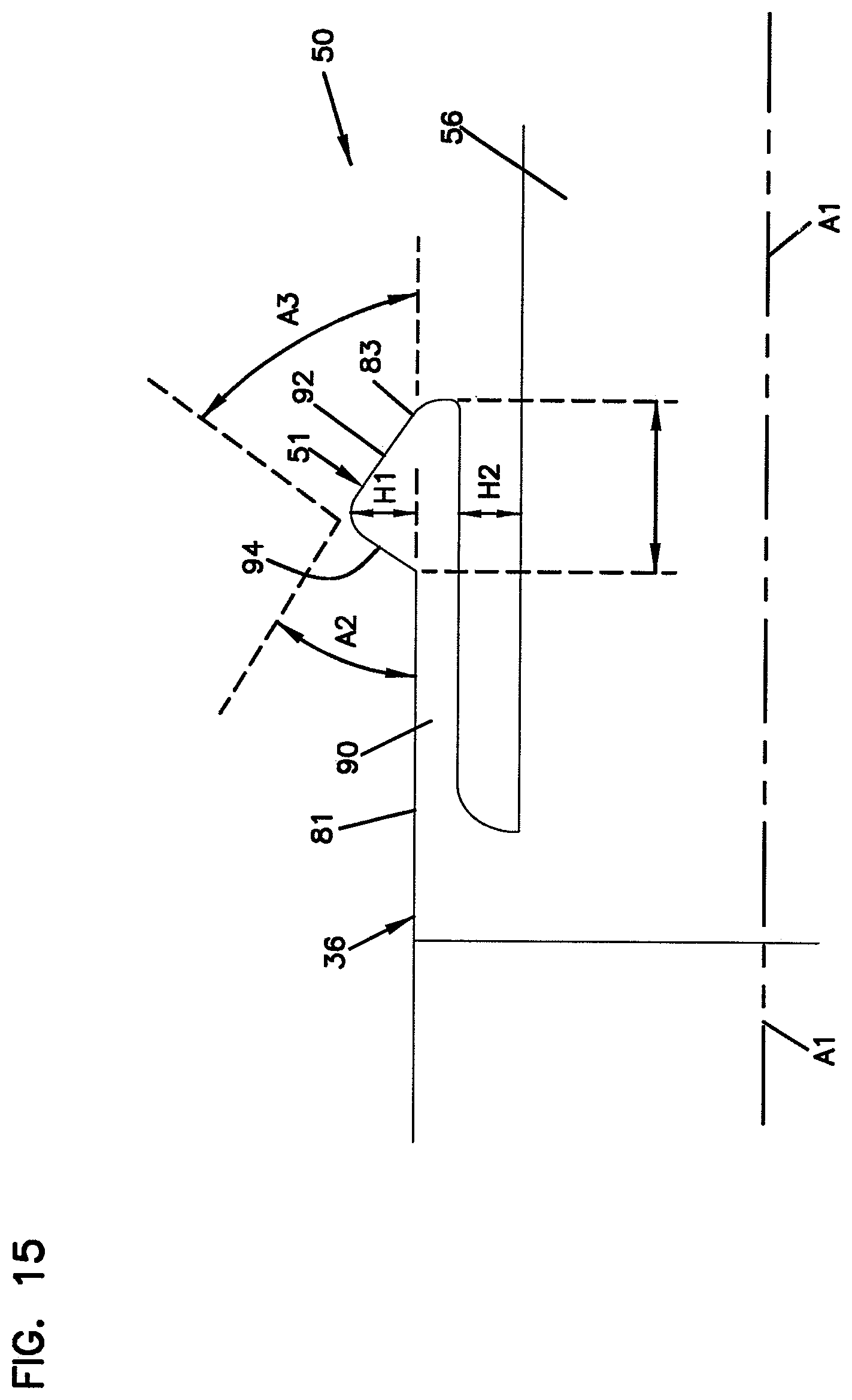
D00013
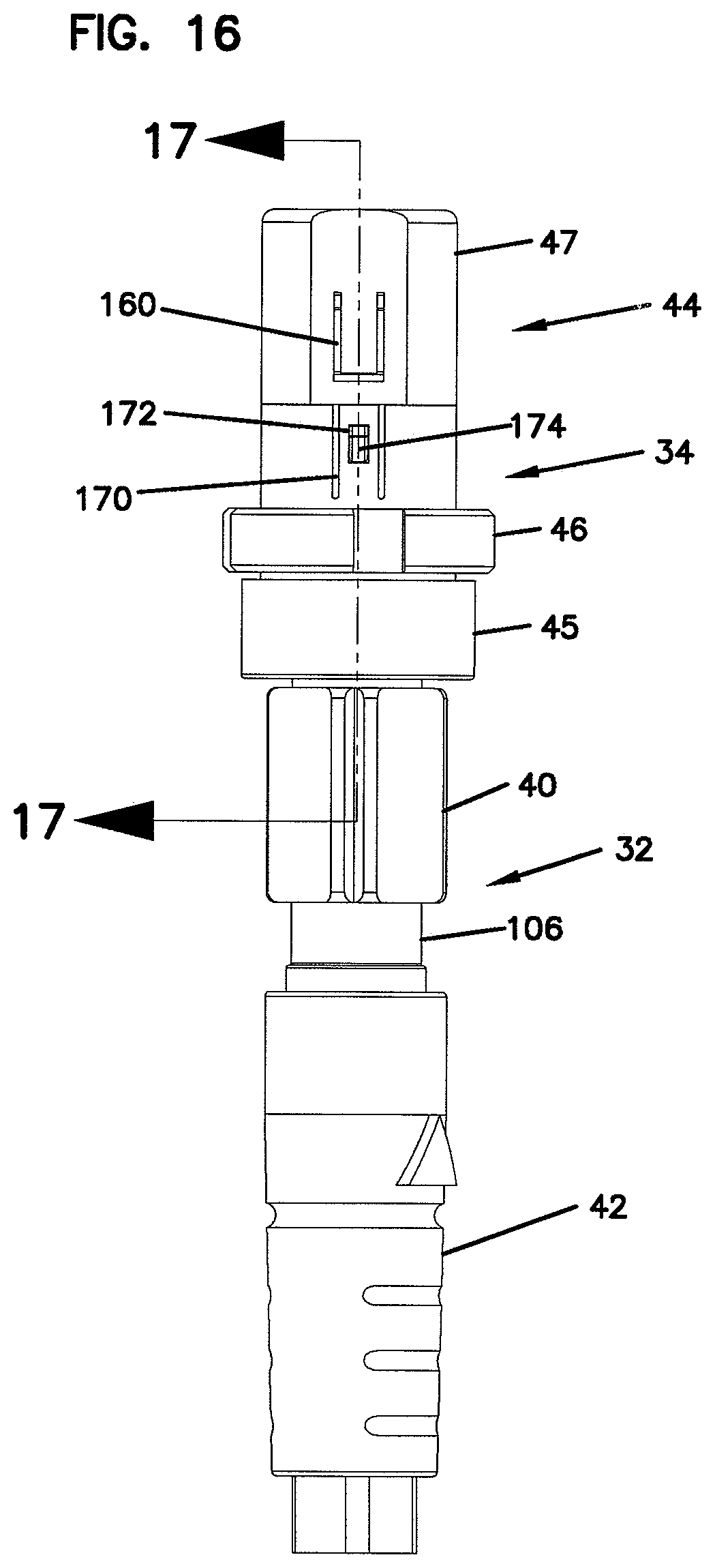
D00014
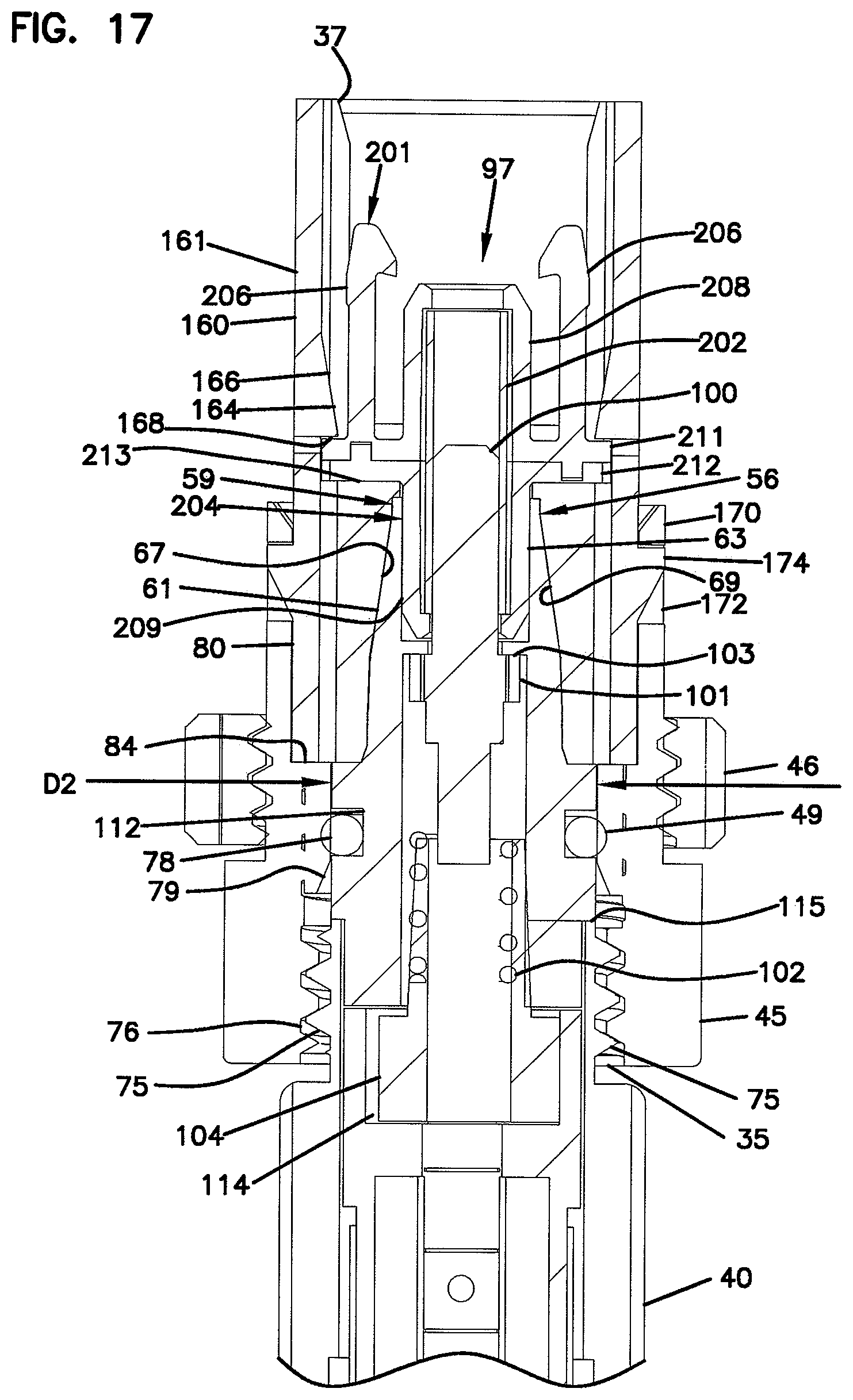
D00015
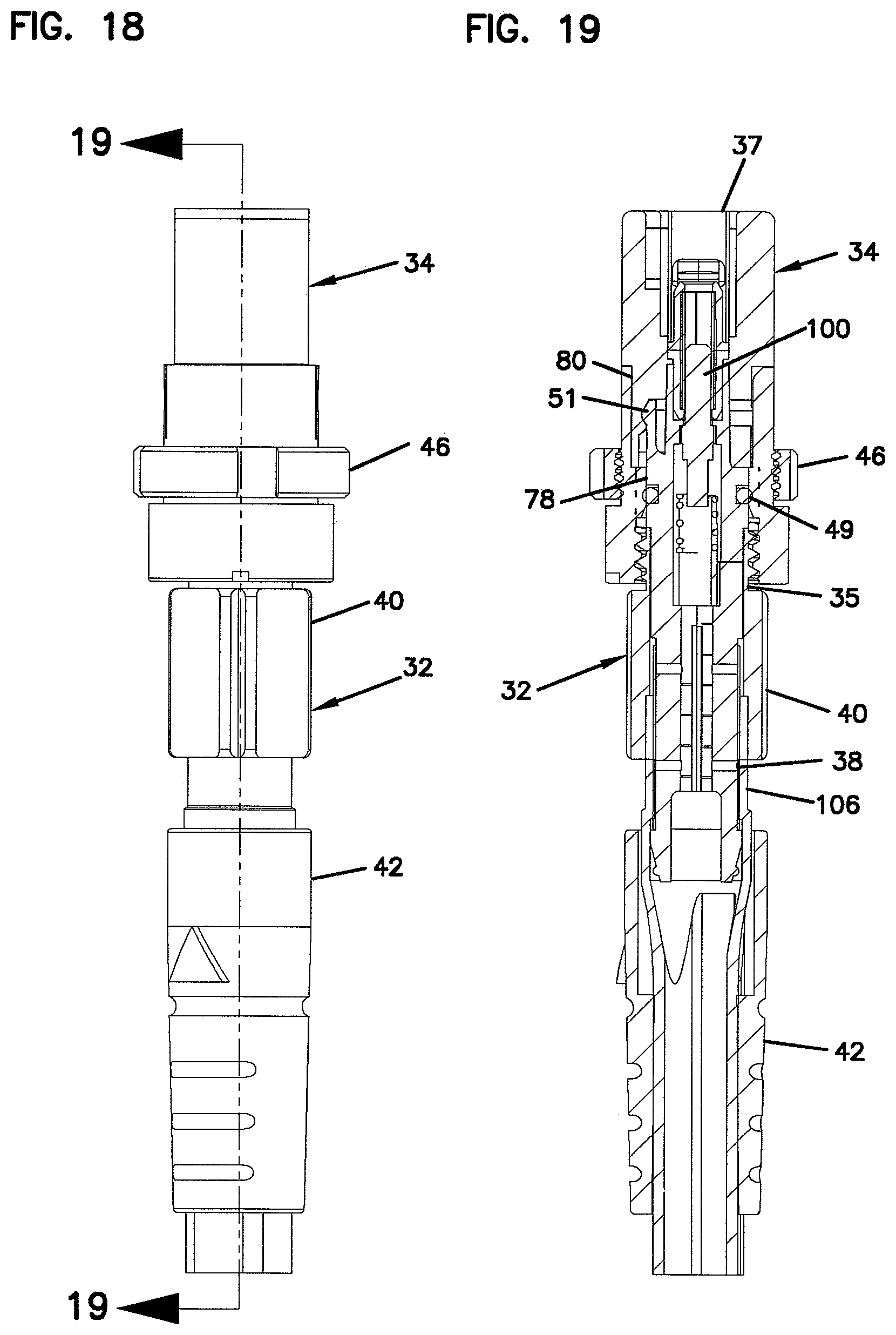
D00016
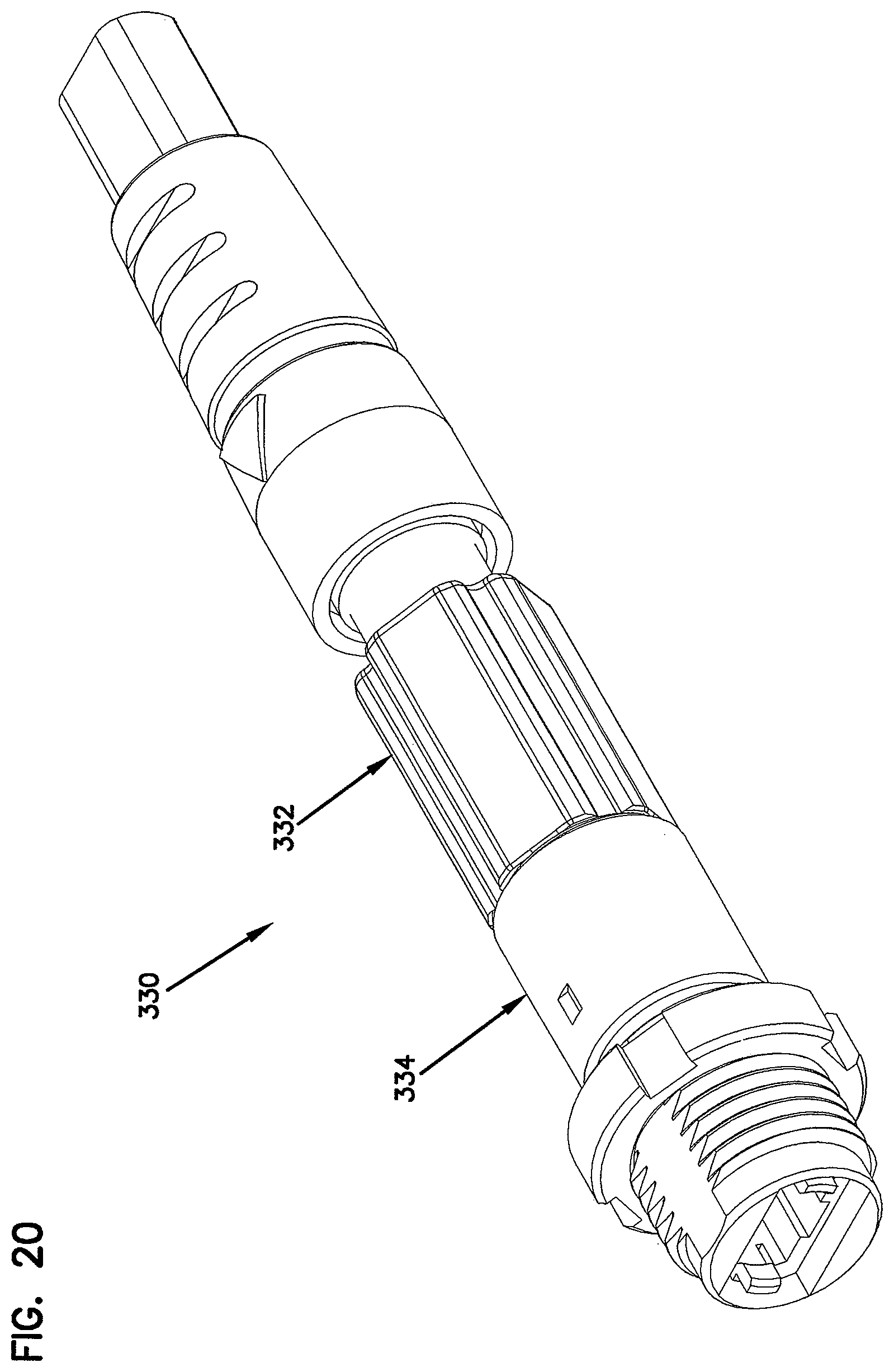
D00017
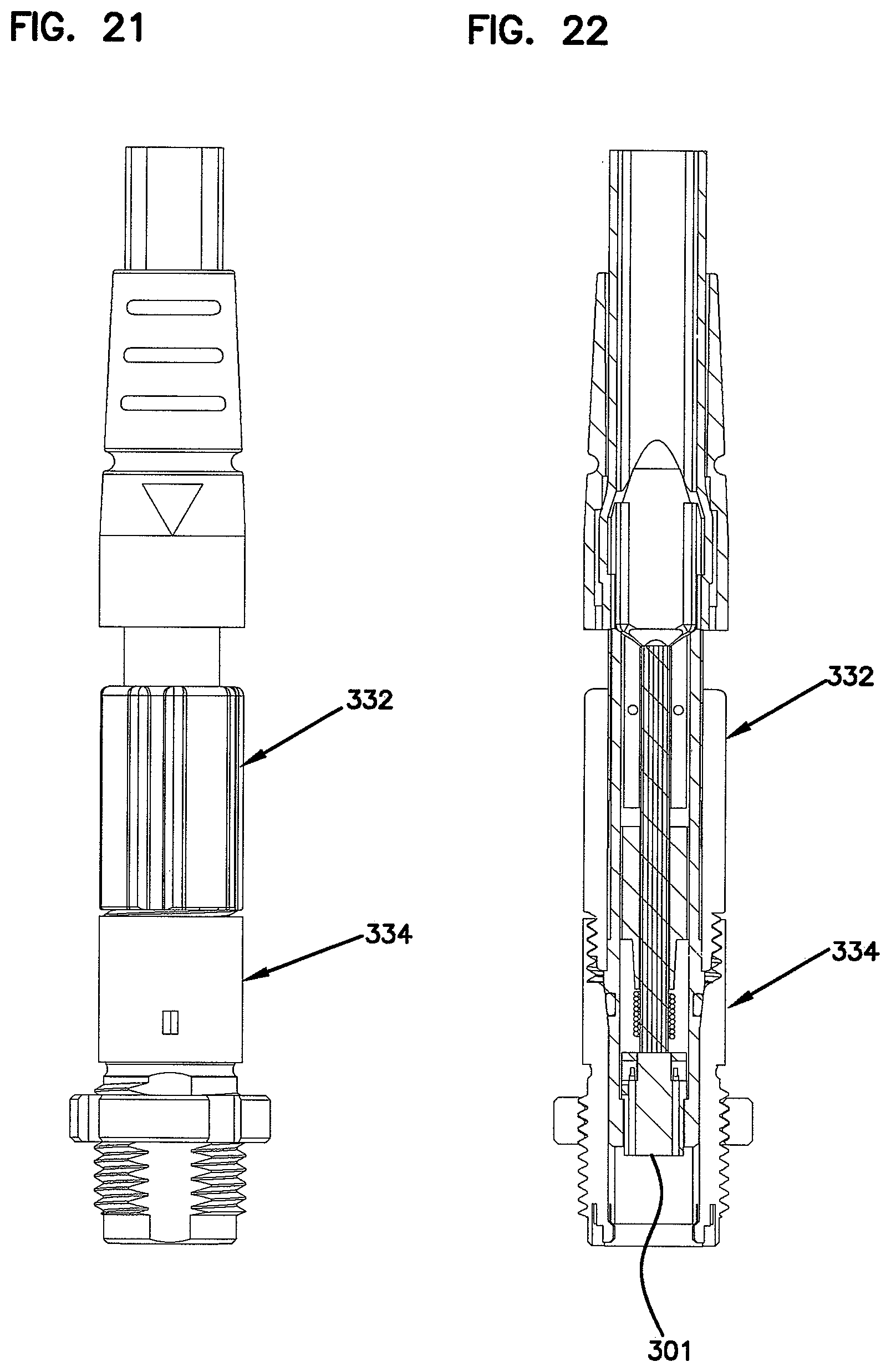
D00018
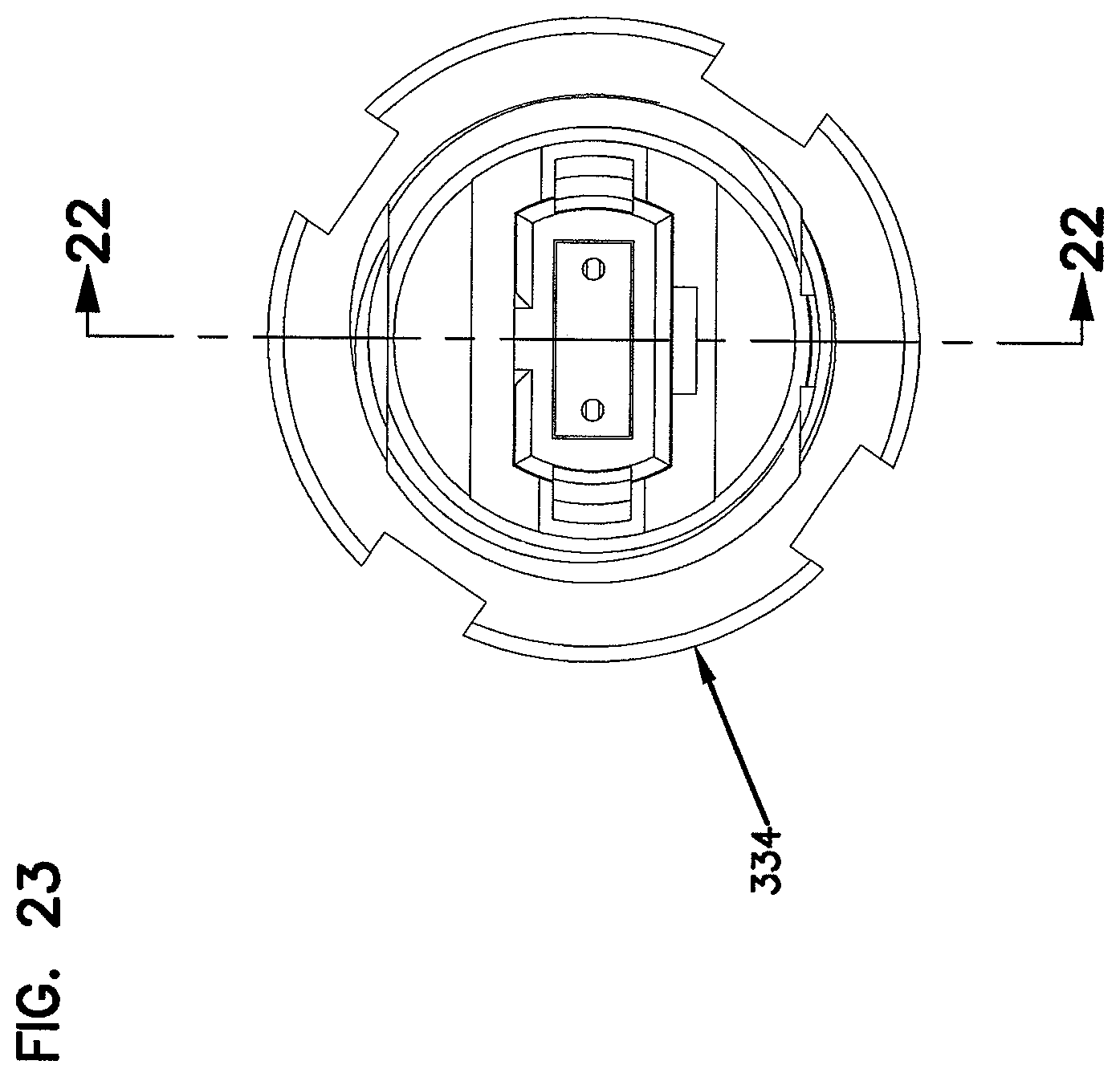
XML
uspto.report is an independent third-party trademark research tool that is not affiliated, endorsed, or sponsored by the United States Patent and Trademark Office (USPTO) or any other governmental organization. The information provided by uspto.report is based on publicly available data at the time of writing and is intended for informational purposes only.
While we strive to provide accurate and up-to-date information, we do not guarantee the accuracy, completeness, reliability, or suitability of the information displayed on this site. The use of this site is at your own risk. Any reliance you place on such information is therefore strictly at your own risk.
All official trademark data, including owner information, should be verified by visiting the official USPTO website at www.uspto.gov. This site is not intended to replace professional legal advice and should not be used as a substitute for consulting with a legal professional who is knowledgeable about trademark law.